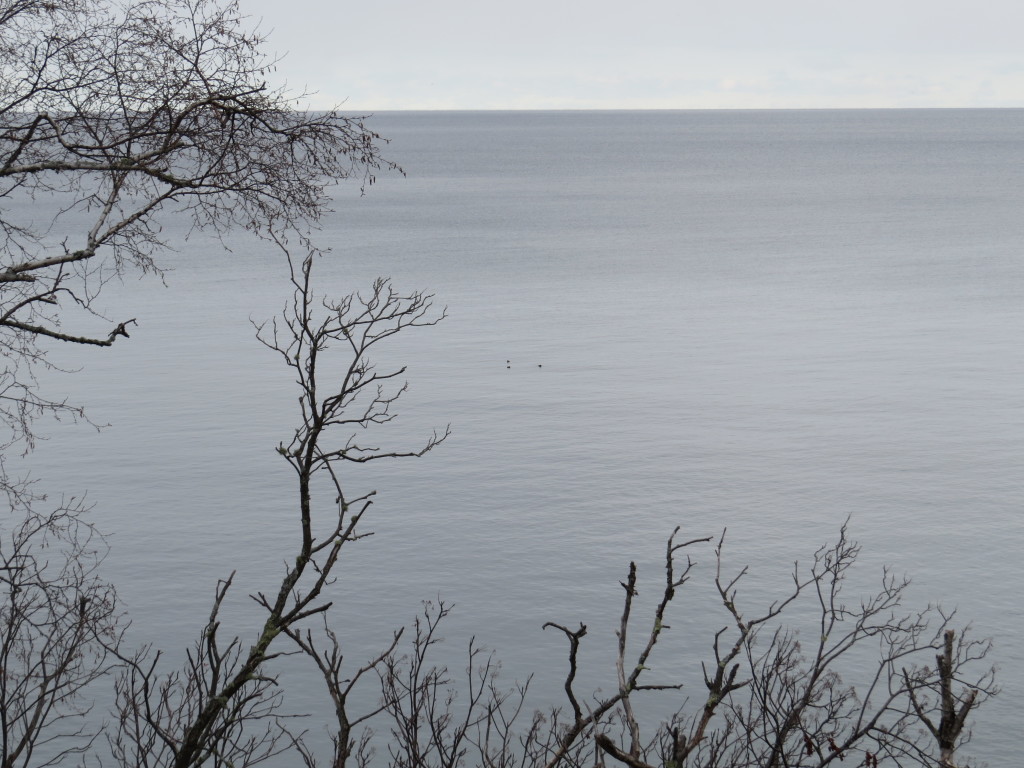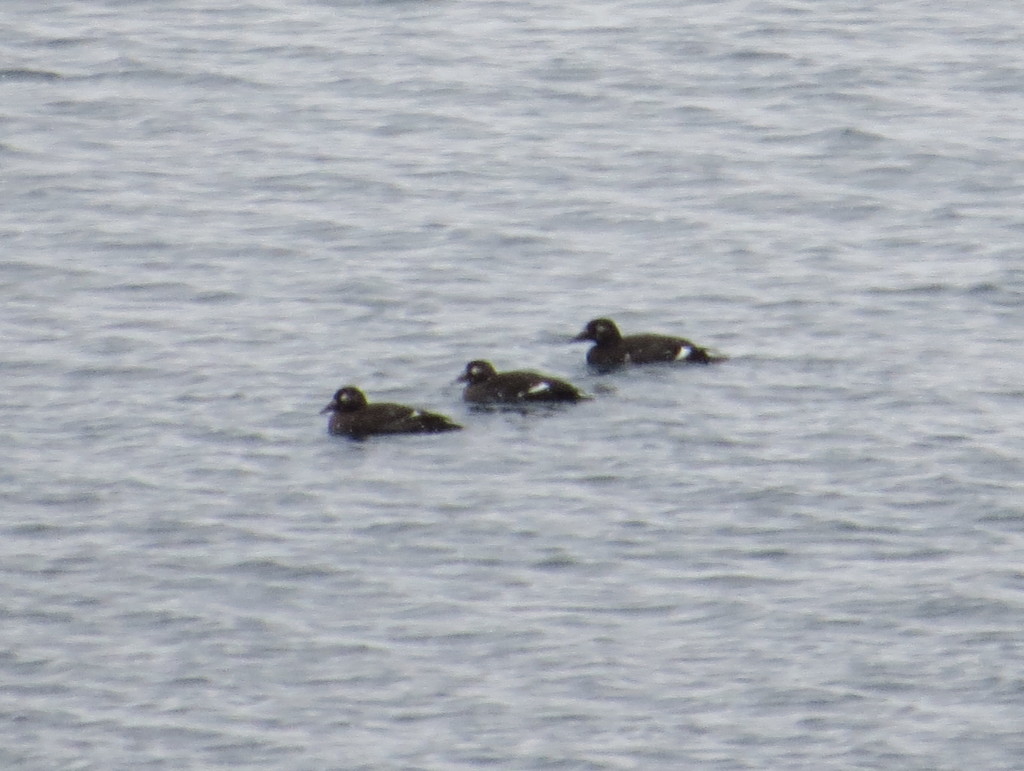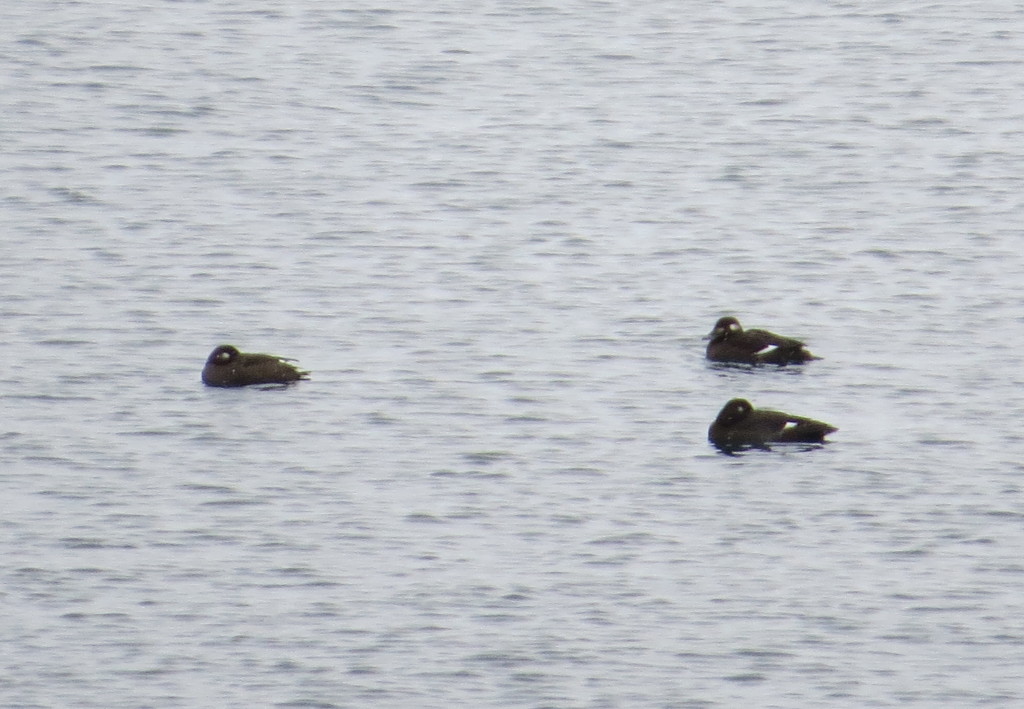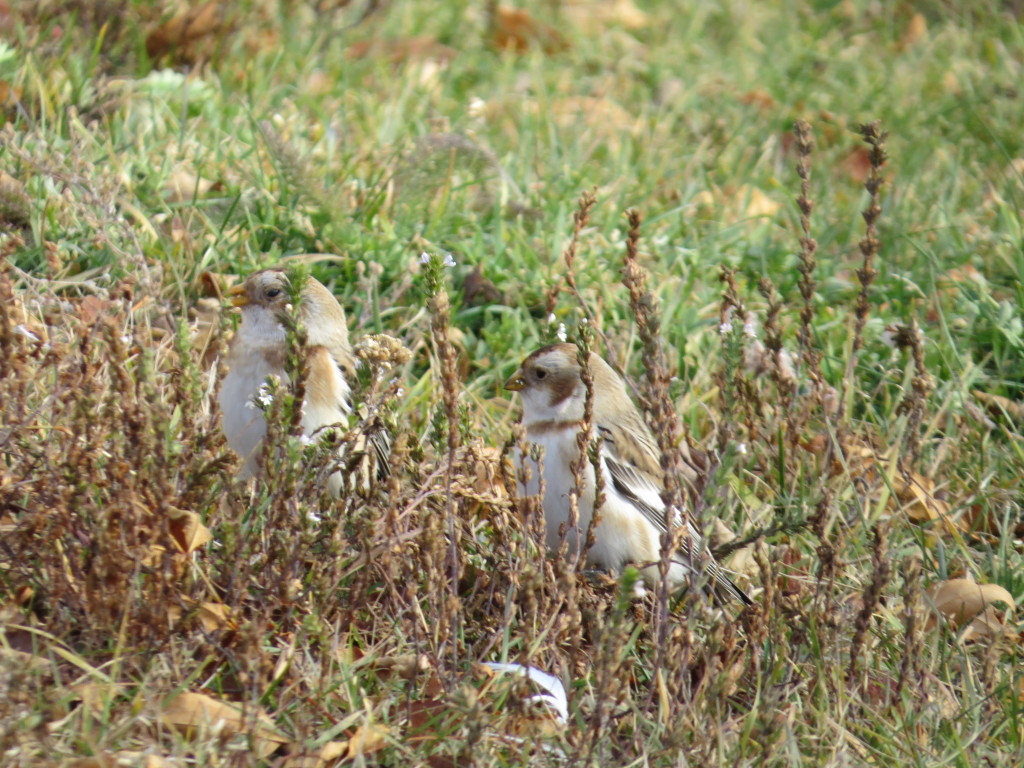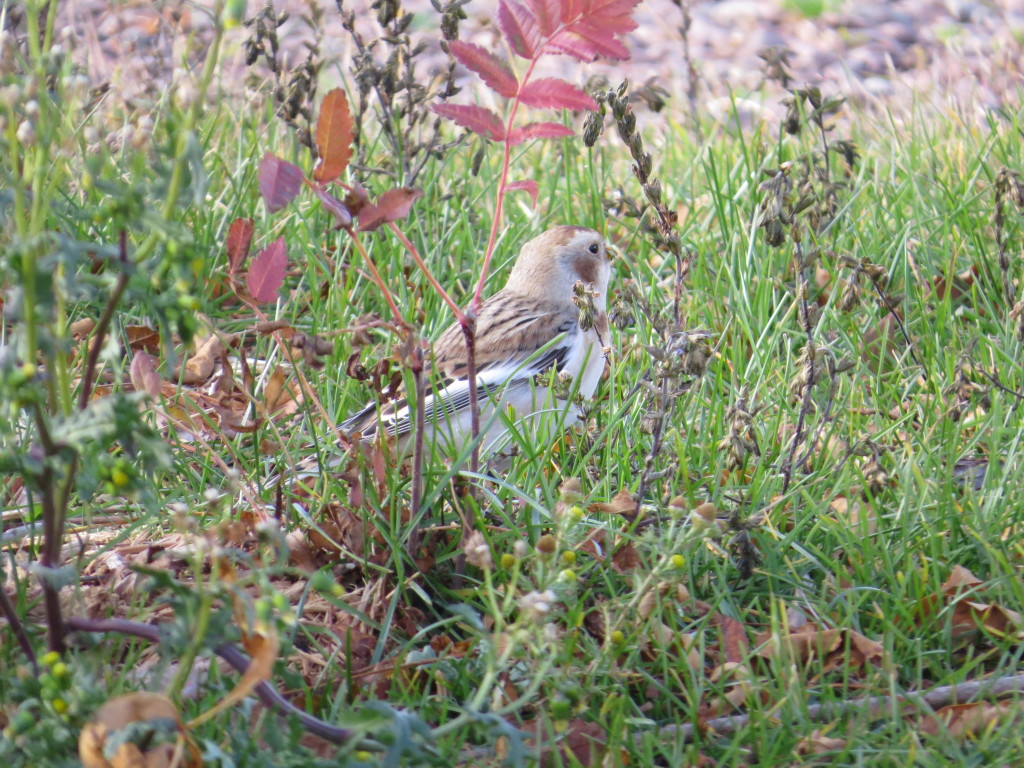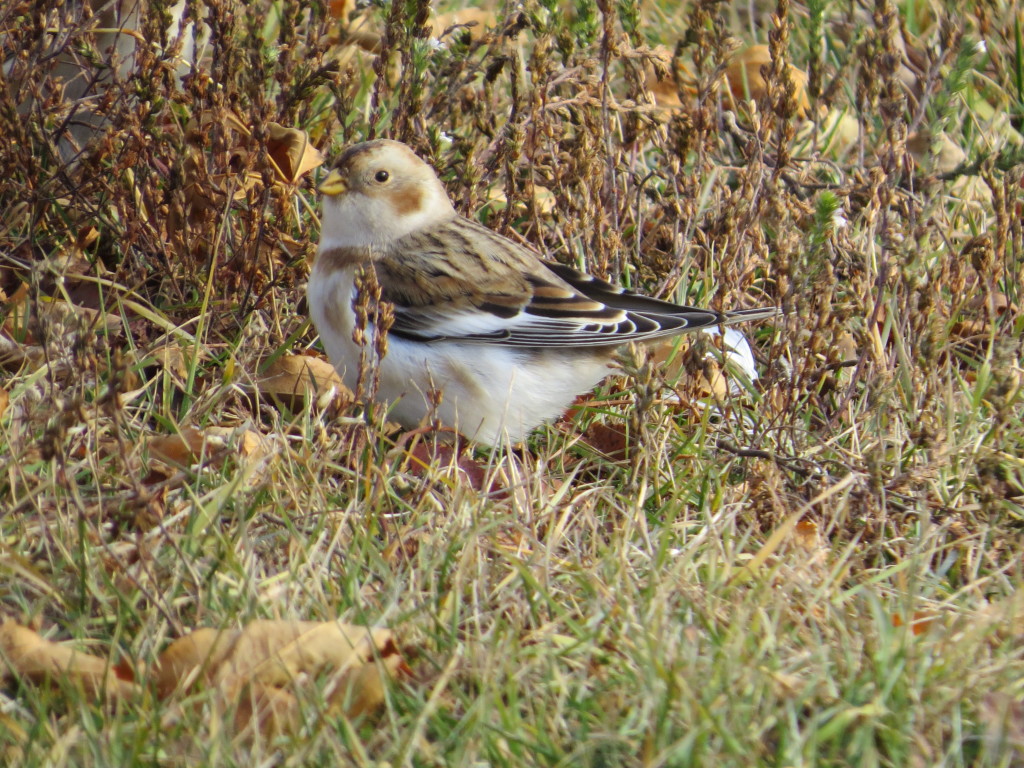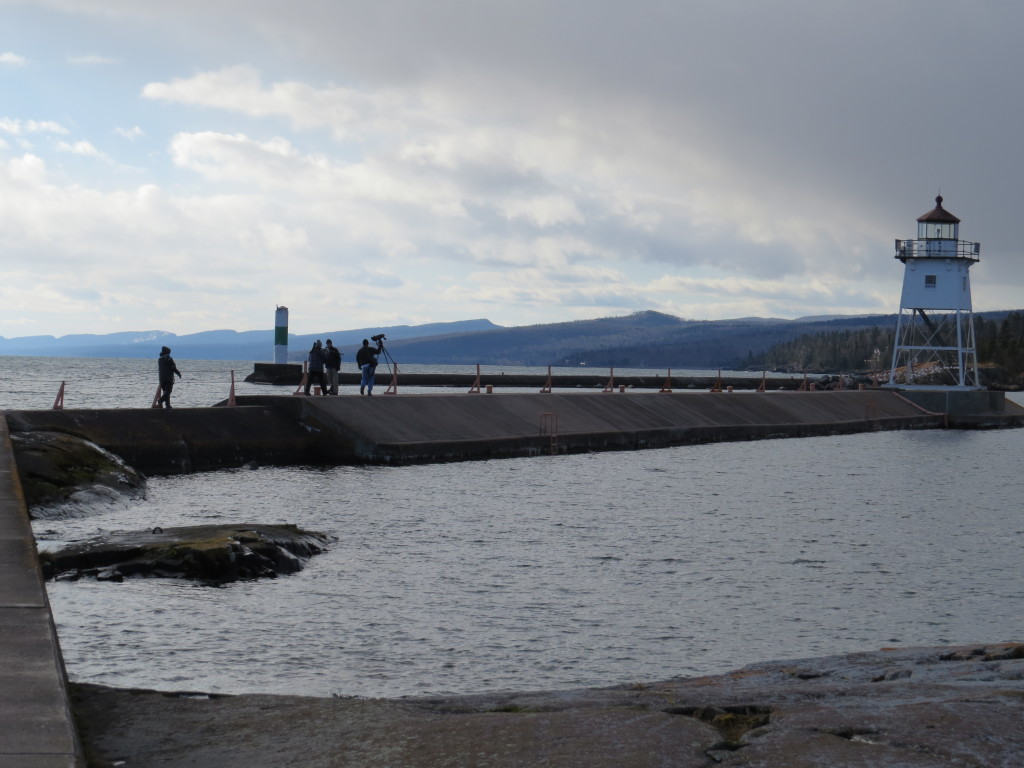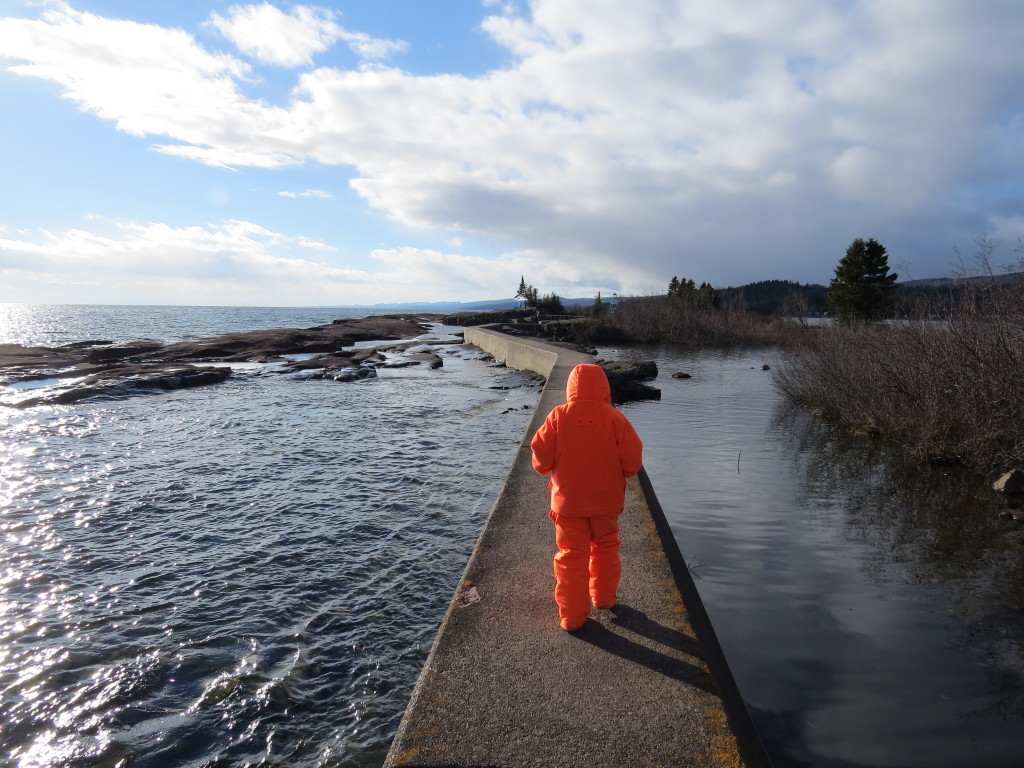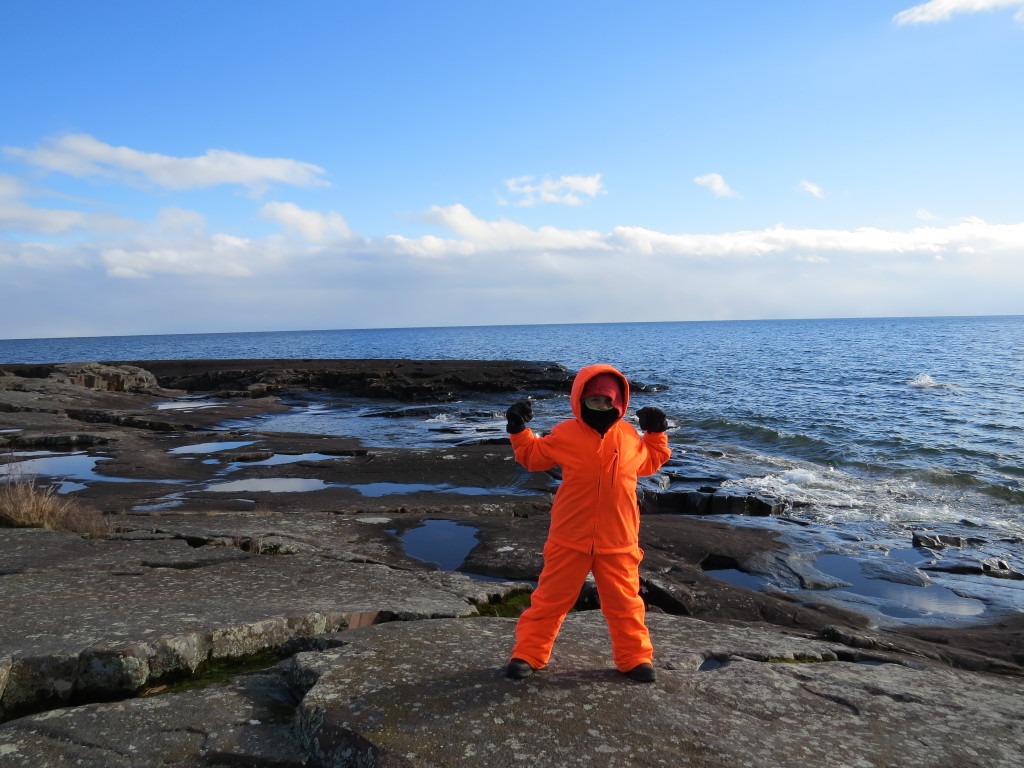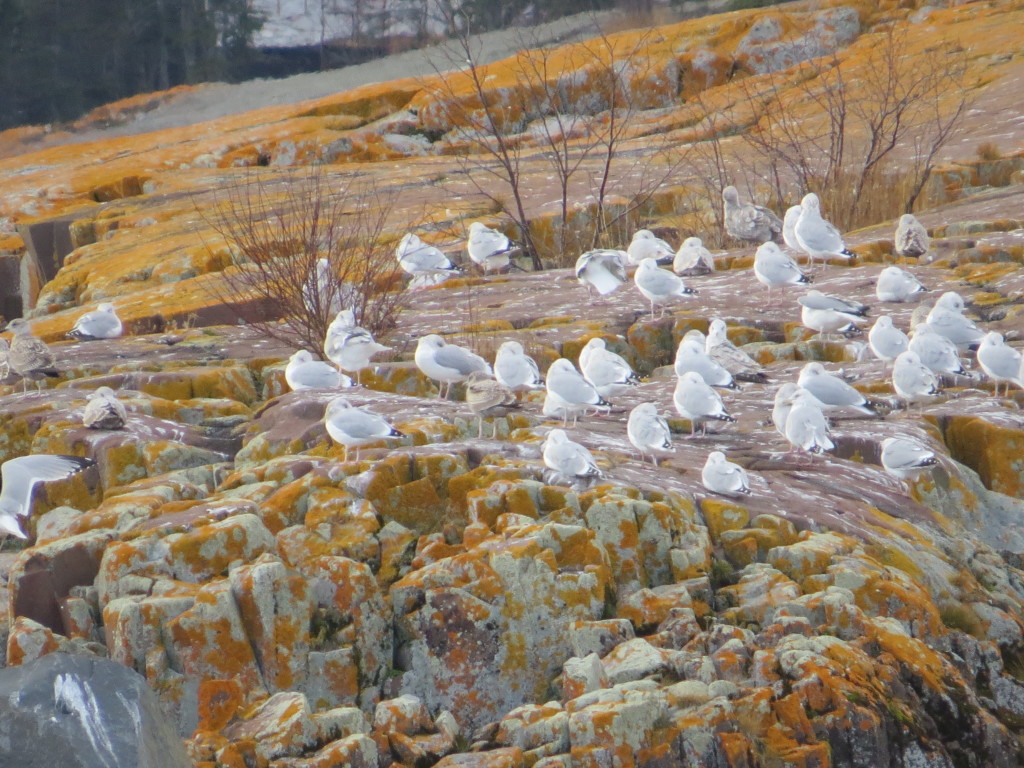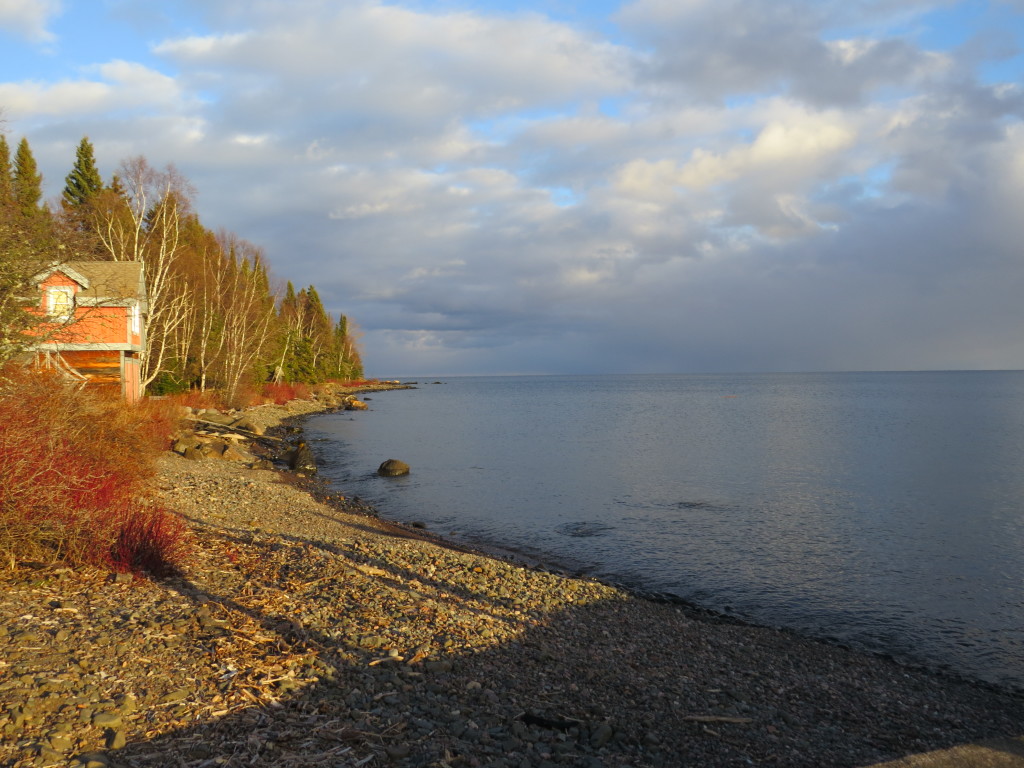Oh, Canada, how you grab our imagination, especially as birders. Perhaps no other bird signifies the Far North and gets stuck on birders’ brains quite like the Northern Hawk Owl. Though Hawk Owls occasionally breed in the boreal forests of northern Minnesota, they are most often seen in winter when birds decide to cross the border for the season. They are a highly coveted bird for any birder. Most birders get their Hawk Owl lifer in Minnesota. That’s exactly what Arizona birding friends Tommy DeBardeleben and Gordon Karre were hoping to do. One problem, though: Hawk Owl reports were virtually non-existent in Minnesota this winter. There were only a couple of scattered reports from the under-birded, remote counties of northwestern Minnesota. This bird failed to show up in the Arrowhead this year despite being fairly regular around the Sax-Zim Bog and Duluth in recent winters.
Of course, this reality, which was was not improving with each passing day, was weighing on me prior to Tommy and Gordon’s arrival. It would mean that if we wanted to even TRY for this bird, we’d have to travel some 3.5 hours north and west of my parents’ place in northern Minnesota. We’d be going right to the Canadian border on the west side of that “bump” on Minnesota’s northern border. All told, this is about 7 hours away from Minneapolis/St. Paul. It’s up there, folks. I’ve been up that way maybe only twice in my life, but never as a birder. It was new turf, remote turf, that I’d be exploring in the winter. I’d be lying if I said the thought of it didn’t make me nervous and give me pause. Once I accepted the reality that we’d have to venture into the northwest, I began to devour any scrap of birding news out of that remote country. The more I pored over maps and read up on Roseau and Lake of the Woods Counties in some old Minnesota birding books, the more excited I was getting. Visions of Hawk Owls, gobs of Great Grays, two species of Crossbills, Black-backed Woodpeckers, and Spruce Grouse flooded my mind. (Sometime if you’re bored, do an eBird query for Great Gray Owls and see the dozens upon dozens that Hawk Ridge’s Karl Bardon found around Roseau in February of 2013.) The lack of Hawk Owls in northeast Minnesota was actually a good thing–it was getting me out of my comfort zone and getting me to explore an area that I’ve always wondered about. Birding is often as much about exploring as it is seeing birds.
So on January 31st, our third day of the big northern Minnesota birding adventure, Tommy, Gordon, and I left base camp in Angora at 4 AM to reach MN Highway 310 north of Roseau by first light. This would be the furthest point from home we’d be exploring, so we’d be birding our way back home from the start of daylight. It was surprisingly foggy on our way to Roseau. Once we made it to MN 310, the 10-mile road to Canada, we first took a run up the Sprague Creek Road as this time of day was prime for Great Grays and Spruce Grouse. The road was not what I expected though, as we went through a lot of Aspen and open areas. We could see Black Spruce and Tamarack bogs, but never came close to them. However, it was good to explore this road and see where many Great Grays have been seen in the past, including one earlier this winter. Gordon did find us a Black-billed Magpie, but otherwise it was dead up that way.
Once back at MN 310, we turned north and the countryside changed from open fields to Tamarack/Spruce bog. This is one of the most reliable places to see Great Gray Owls in all of Minnesota, and this was the area that a Hawk Owl had been discovered by Sandy Aubol over a month prior to our trip. Yes, we had made a 3.5 hour trek on information that was over a month old! However, Hawk Owls tend to be pretty loyal to their winter territory, so I thought we had a pretty decent chance. Needless to say, we were all on high alert for northern Owls! But all we were seeing was the incredible hoarfrost that developed from the fog.
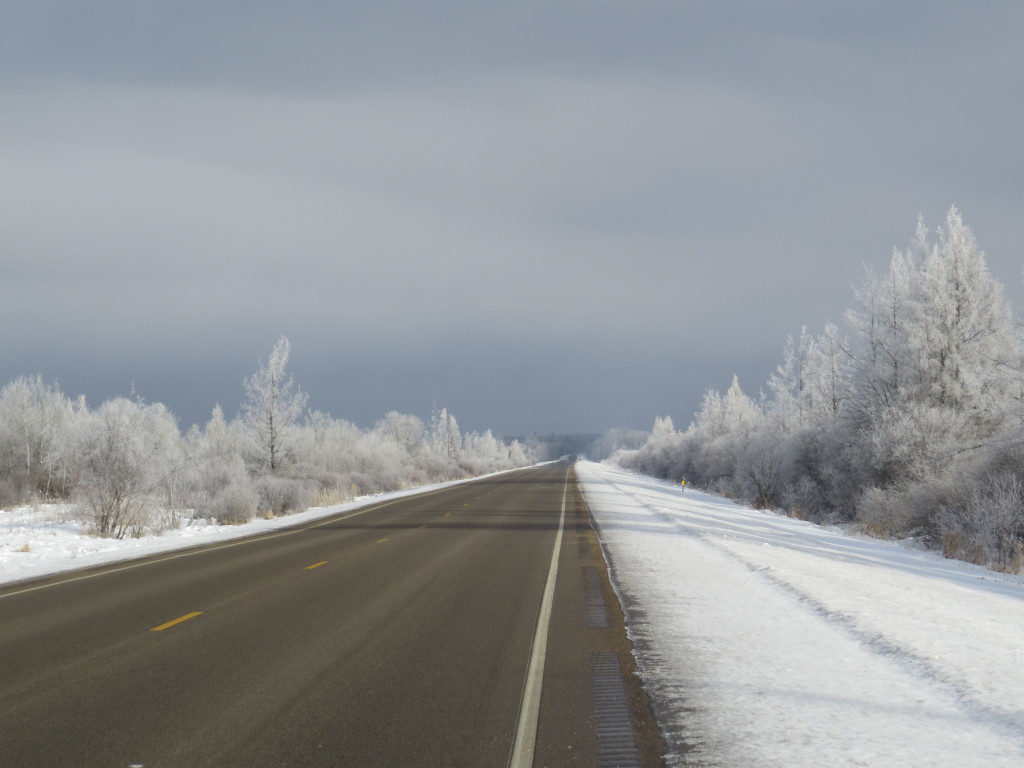
We drove up to the checkpoint at the border and turned around there, having to pass right through the car portal at the guard shack, and nobody was home… So, so weird. The dumpster on this property was enclosed in a chain link fence topped with concertina wire, yet nobody was there to stop wackos coming in to the United States?!? Such a different experience than when I crossed into New York a decade ago and got grilled by our own border patrol for why I was returning to the country where I…live. I guess things are just a little more laid back here in the north. To be fair, some Minnesotans have to travel through Canada to get to where they live in Angle Inlet (the bump). That “bump” is composed mostly of water, so the only way to get to Angle Inlet without going into Canada is by boat or snowmobile.
Back to the birding story, we still hadn’t seen Sandy’s Hawk Owl despite a couple passes on 310. I had other Hawk Owl prospects lined up, so I asked the guys if they wanted to make another run up and down the highway for this one or if they were ready to go after a different one. They opted for another try at this first bird. It was another wise decision because once I turned the car around to go north one more time, I spotted their third main target of the trip. It felt good to finally beat Tommy at spotting an Owl because he’s really, really good at it! Of course, this is the only kind of Owling I excel at–finding blobs on tops of bare trees right next to the road.
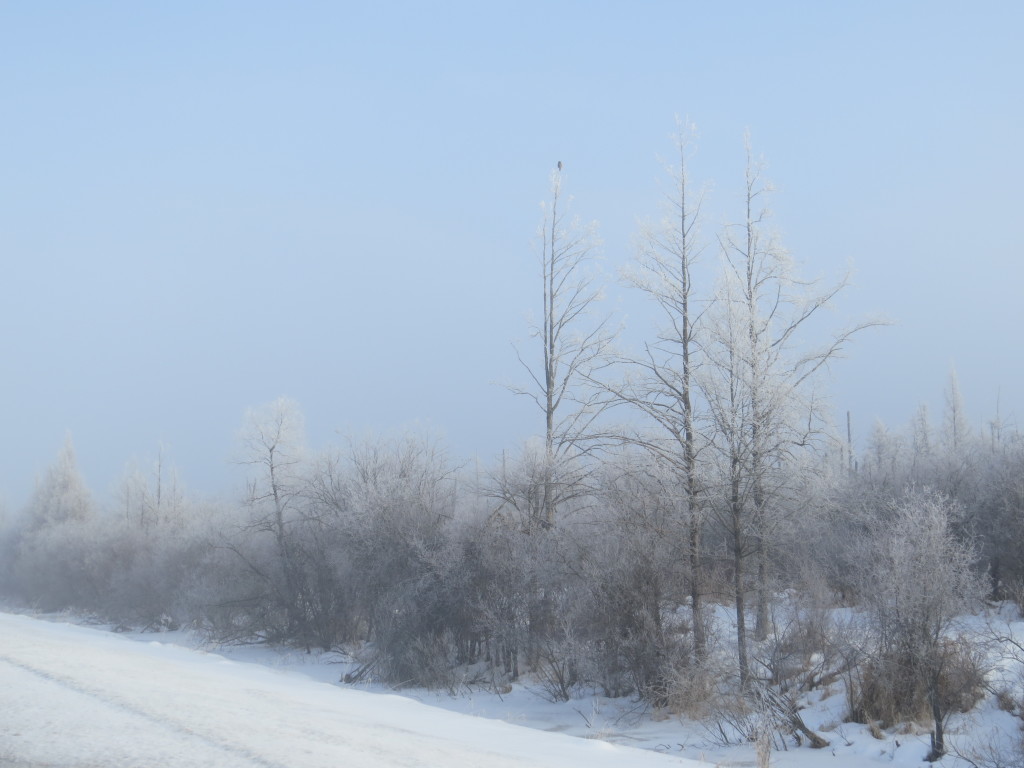 Brakes were deployed, and doors were flung open. It was a happy moment indeed. If you look, you can even see a big smile on Tommy’s face in this pic.
Brakes were deployed, and doors were flung open. It was a happy moment indeed. If you look, you can even see a big smile on Tommy’s face in this pic.
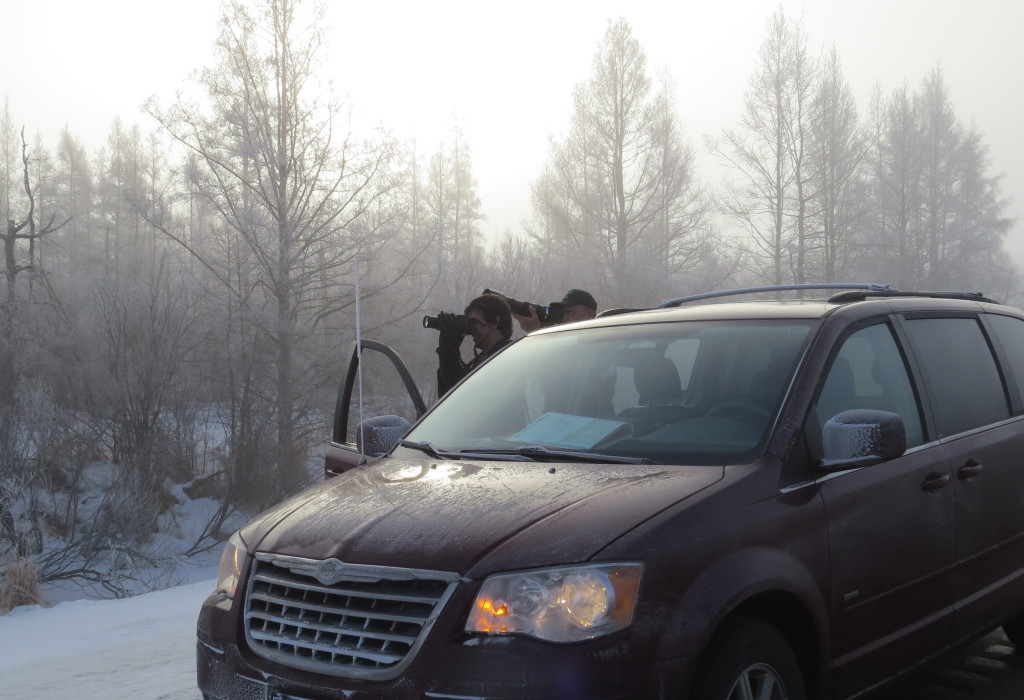 I’ve seen plenty of Hawk Owls, so it was fun to watch these guys enjoy the moment. For this pic below I actually laid on the cold 310.
I’ve seen plenty of Hawk Owls, so it was fun to watch these guys enjoy the moment. For this pic below I actually laid on the cold 310. 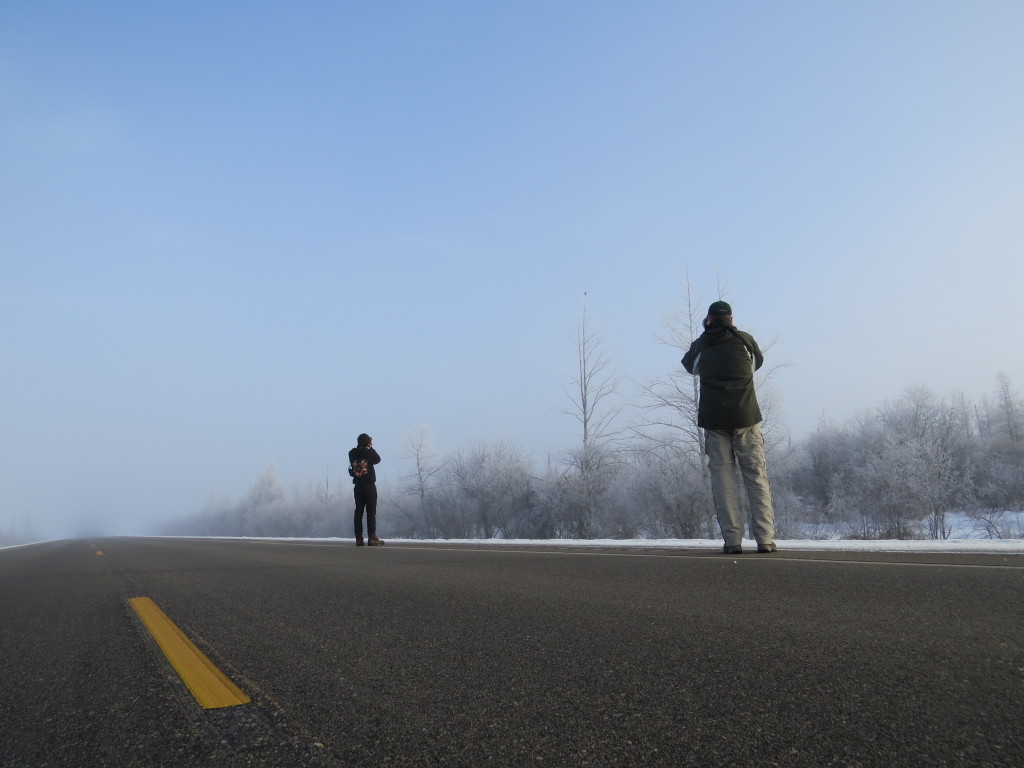 A nice bonus occurred when we were observing the Hawk Owl–Tommy spied their lifer Pileated Woodpecker fly across the road! I had told Gordon all along that if we see a Pileated, that’s exactly how it would happen.
A nice bonus occurred when we were observing the Hawk Owl–Tommy spied their lifer Pileated Woodpecker fly across the road! I had told Gordon all along that if we see a Pileated, that’s exactly how it would happen.
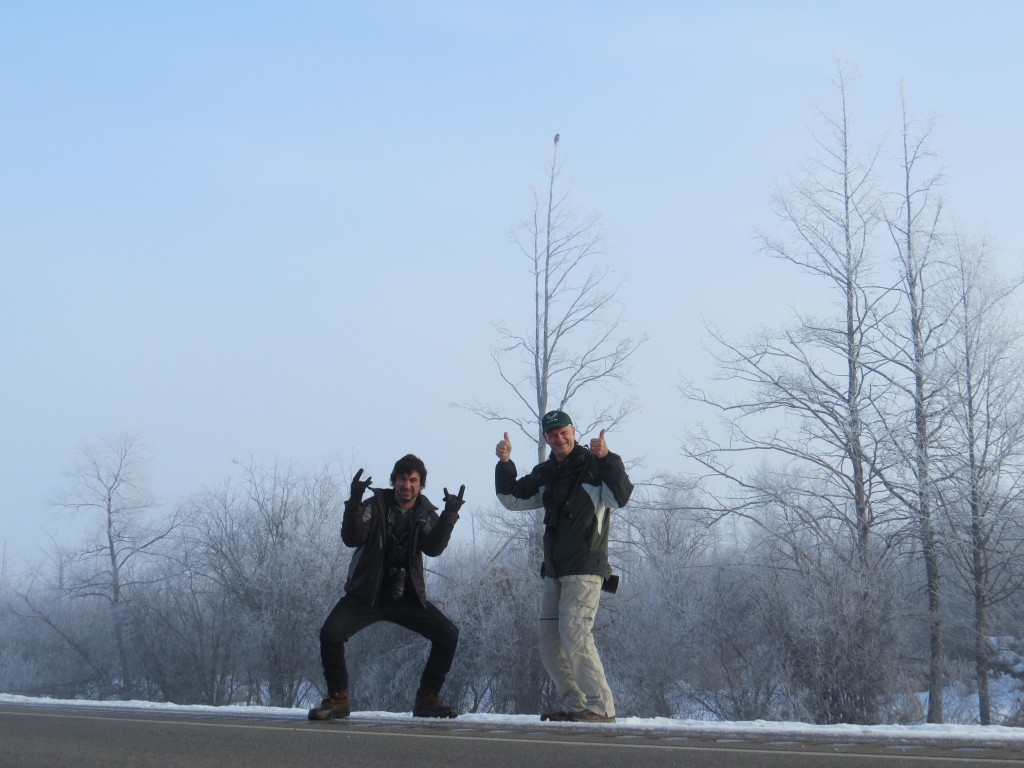
As Canadian cars approached from the north, I wondered what they thought of this scene of the three of us gawkers and imagined their conversations went something like this:
“What are those hosers looking at, eh?”
“Looks like a hawkowl, eh.”
“What’s so special ‘boot a hawkowl, eh?”
“Dunno, eh, saw like 50 on the drive down this morning, eh. It’s not polite to stare, though eh.”
“You’re right, eh, sorry, eh.”
“No problem, eh. Stop the car, eh.”
“Why, eh?”
“There’s a piece of litter we need to pick up, eh.”
The longer we lingered, the more the sun began to burn off the fog and illuminate the incredible hoarfrost. What a site it was, all the better that we were looking at a Hawk Owl in the hoarfrost.
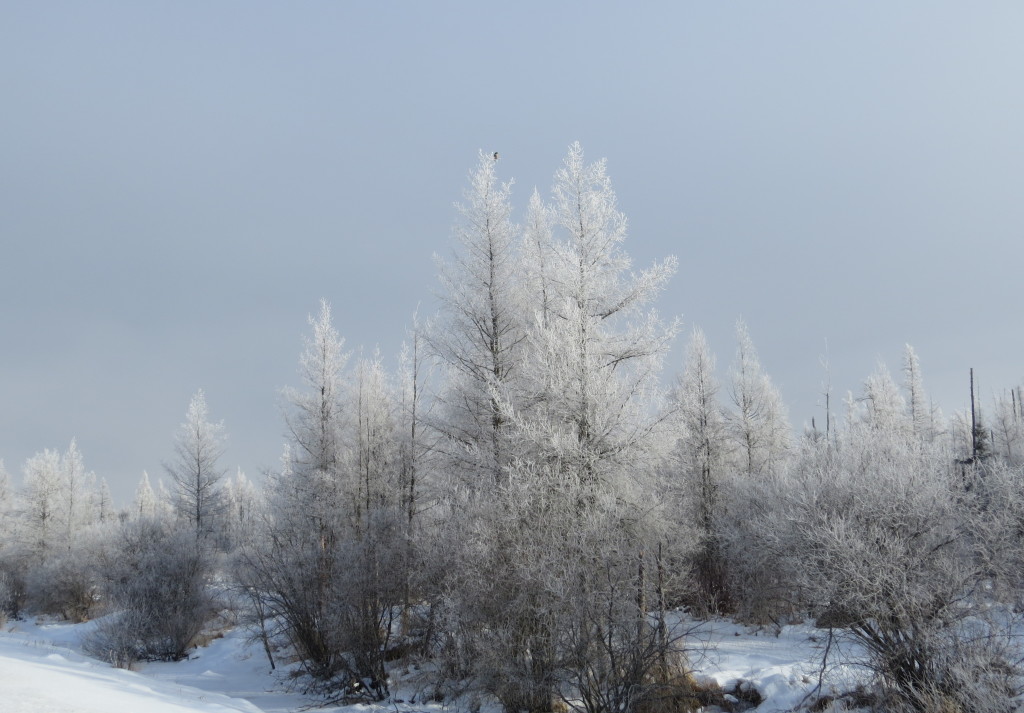
Many Owl photographers could only dream of this perfect set-up. It did not go unappreciated by us.
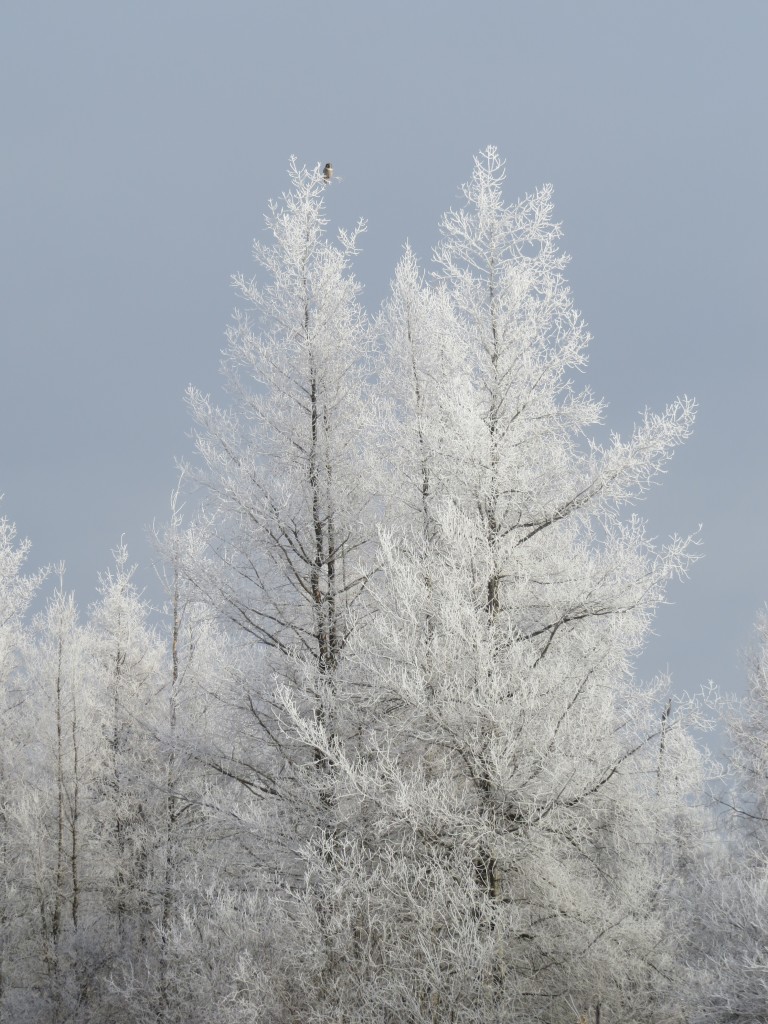
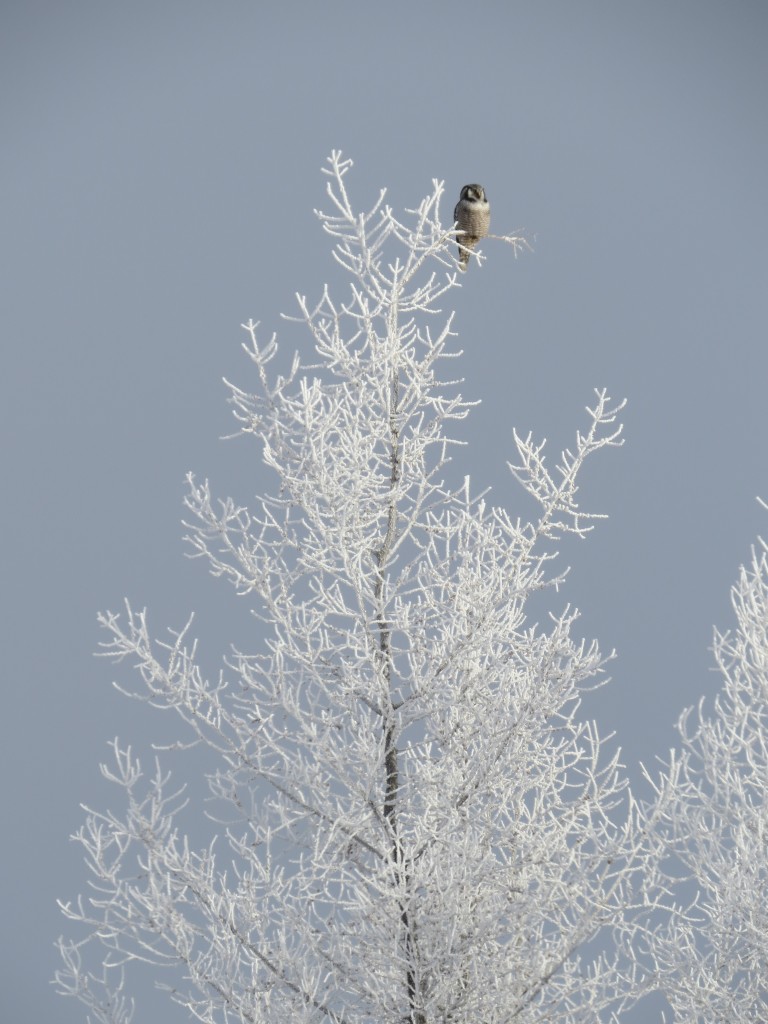
Check out the blood on the Hawk Owl’s bill. Perhaps it was feasting on a mouse somewhere when we made our first pass.
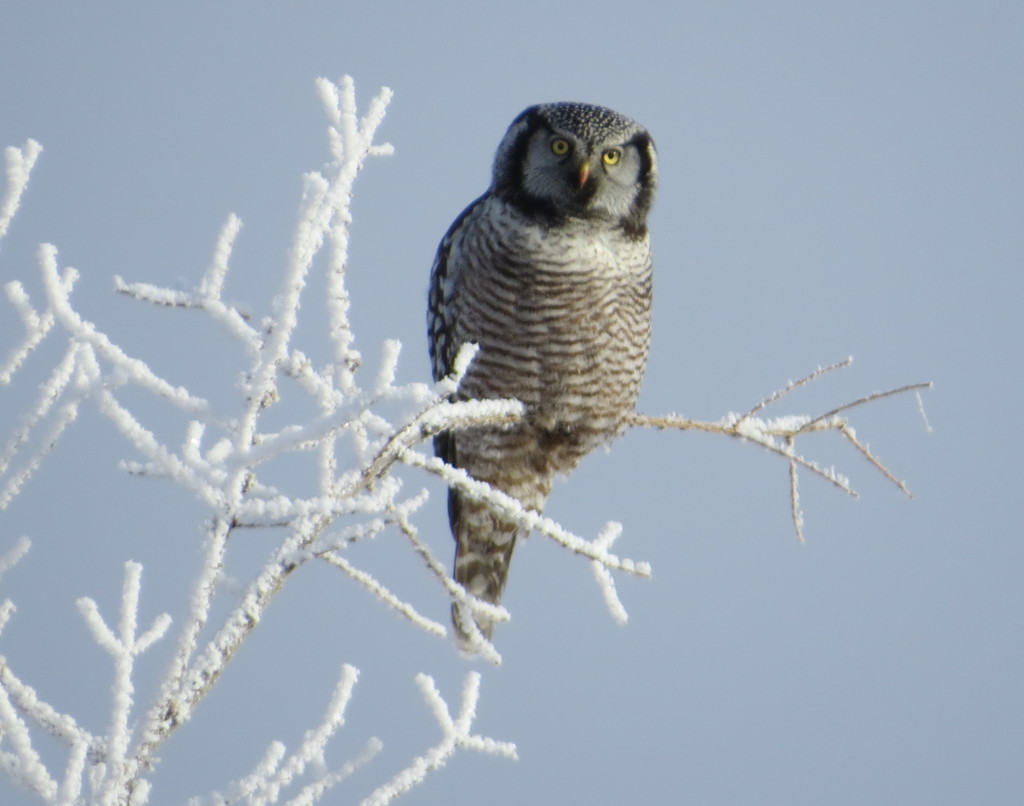
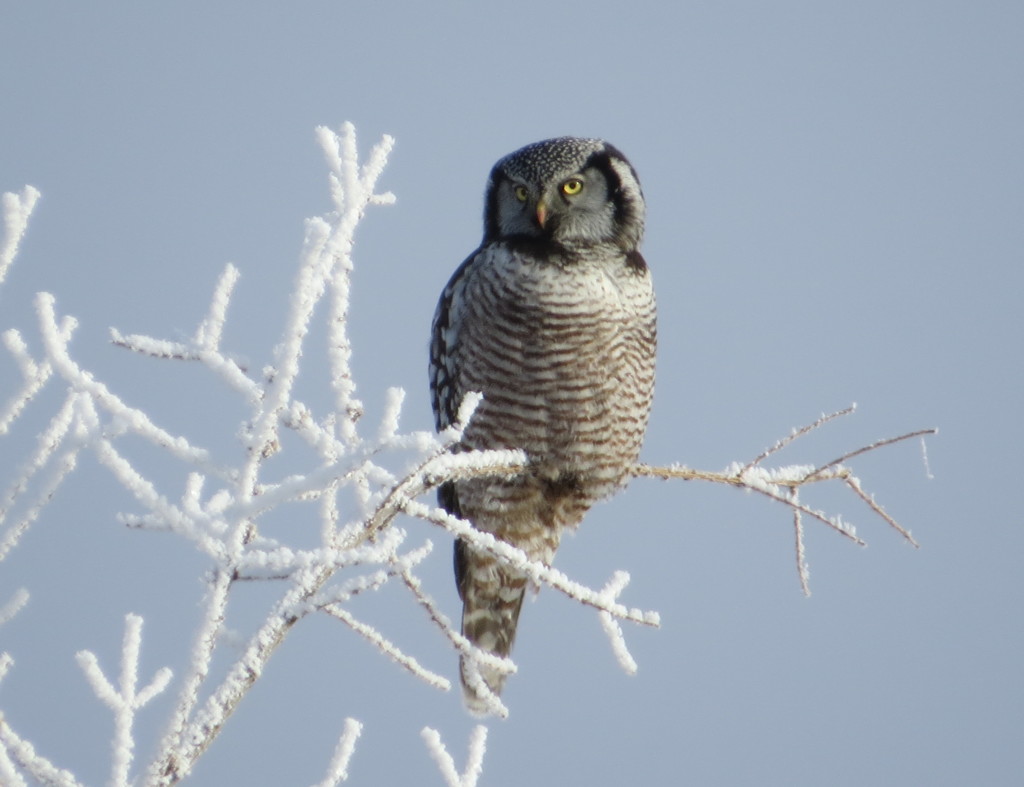
A little while later, the Hawk Owl was on a different frosty perch, only this time the sun was even brighter and the blood was all gone.
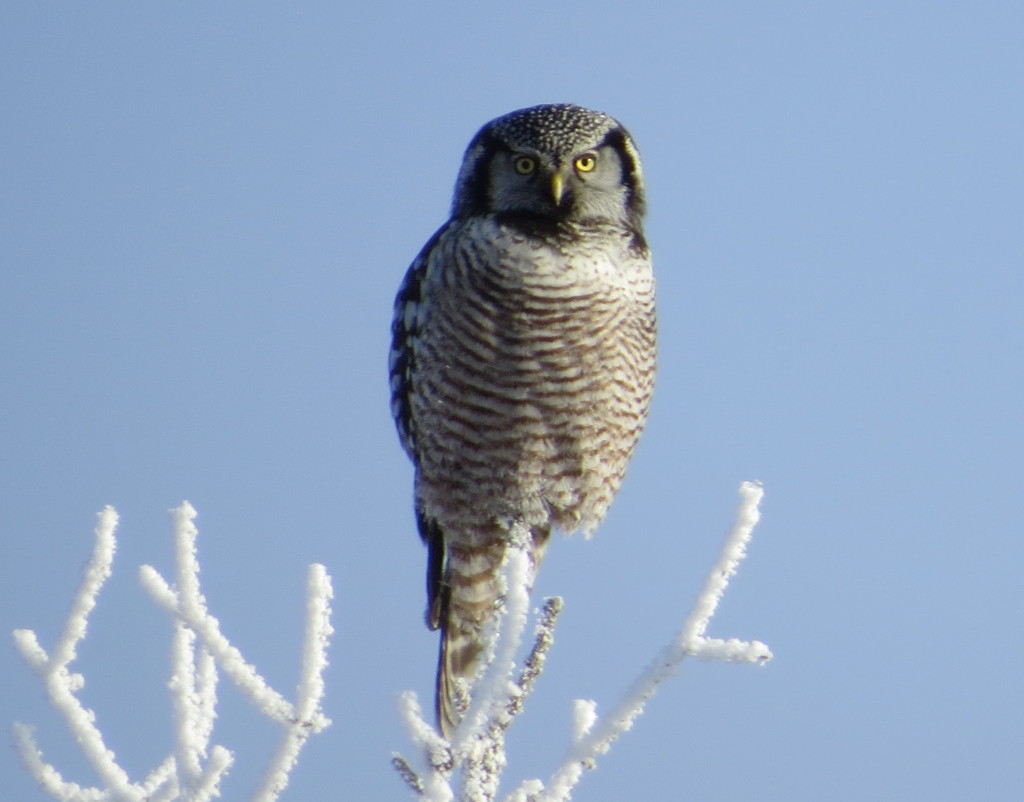
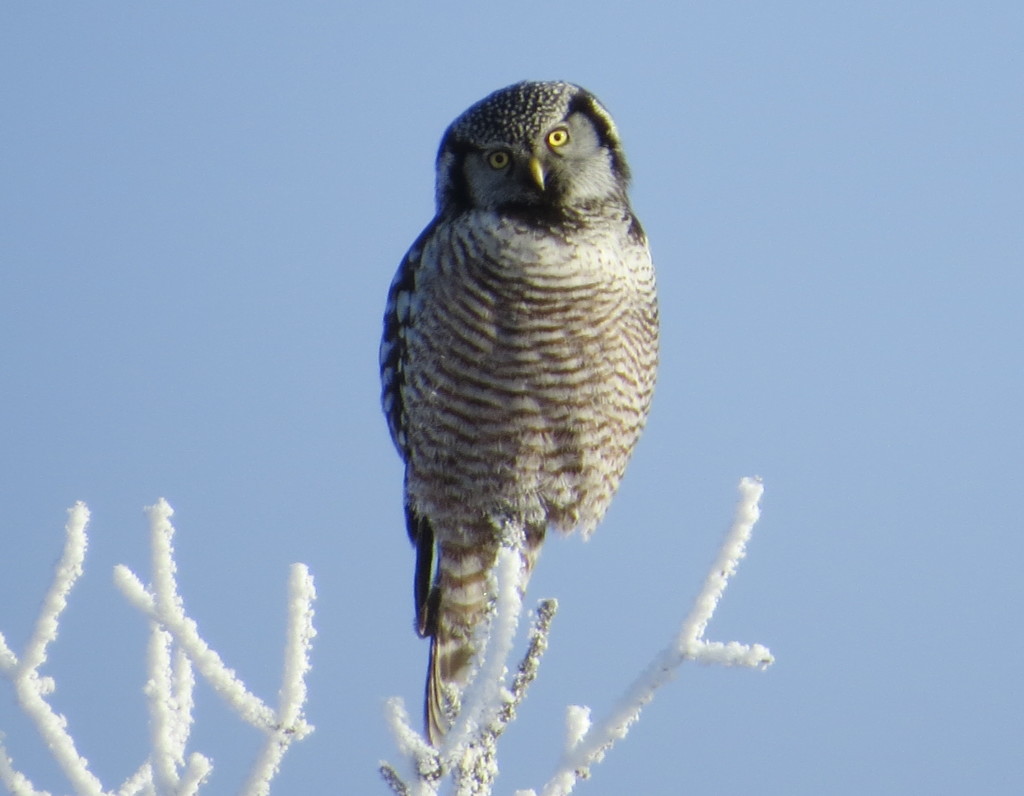
This experience was a lot of fun, even for me. I really, really like Hawk Owls too. There’s just something fun and engaging about them.
We spent some time eating a picnic lunch in the van and started to make plans to head home and look for what would now be bonus Hawk Owls. Our next stop was the Beltrami Island State Forest where a Hawk Owl had been reported on the Roosevelt Road a couple miles north of the Norris Fire Tower. On the way, though, I opted to drive some gravel roads through the open farmland south of MN 11; I had a strong hunch I could get the guys their Snow Bunting lifer if we did. Sure enough, we found a few flocks.
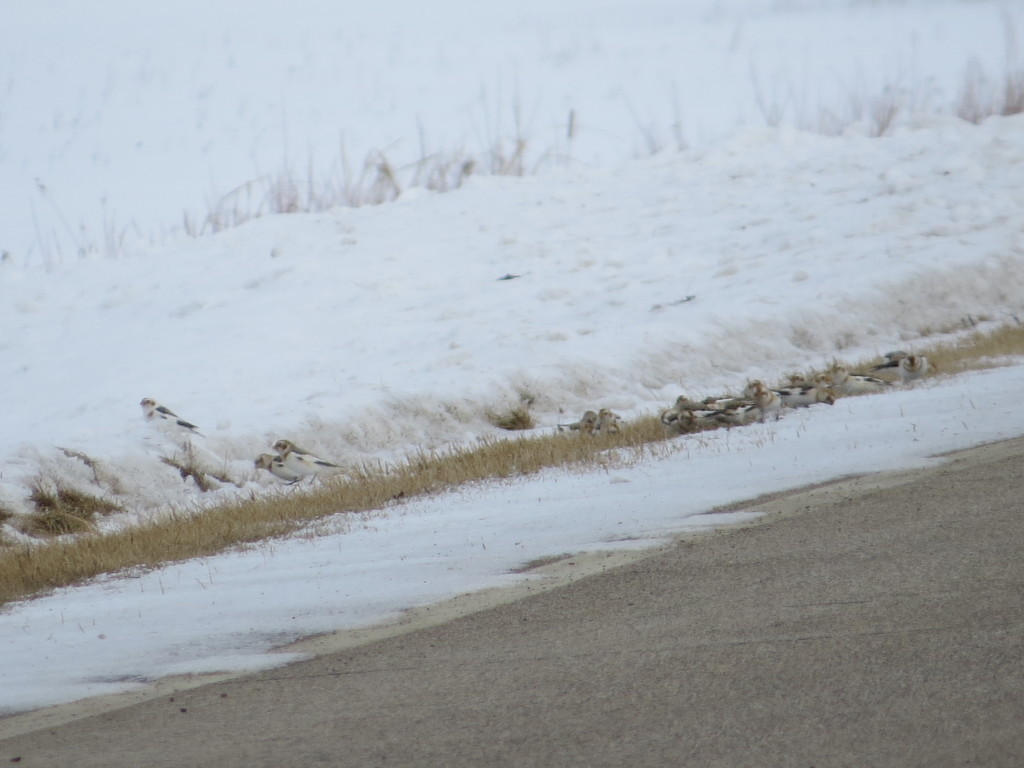 Once we got on the Roosevelt Road, I was very excited. This was a desolate forest we were entering, and I wondered at the possibilities it held for us. There wasn’t a lot of bird life except for some Pine Grosbeaks. Once we got in the vicinity of the reported Hawk Owl, the habitat looked perfect–large open areas surrounded by Tamaracks. It practically screamed Hawk Owl. I mean, it must have, because Tommy heard the message and spotted a super distant, tiny blob in the MIDDLE of a tree that turned out to be…another Hawk Owl!! We were on Cloud 9.
Once we got on the Roosevelt Road, I was very excited. This was a desolate forest we were entering, and I wondered at the possibilities it held for us. There wasn’t a lot of bird life except for some Pine Grosbeaks. Once we got in the vicinity of the reported Hawk Owl, the habitat looked perfect–large open areas surrounded by Tamaracks. It practically screamed Hawk Owl. I mean, it must have, because Tommy heard the message and spotted a super distant, tiny blob in the MIDDLE of a tree that turned out to be…another Hawk Owl!! We were on Cloud 9.
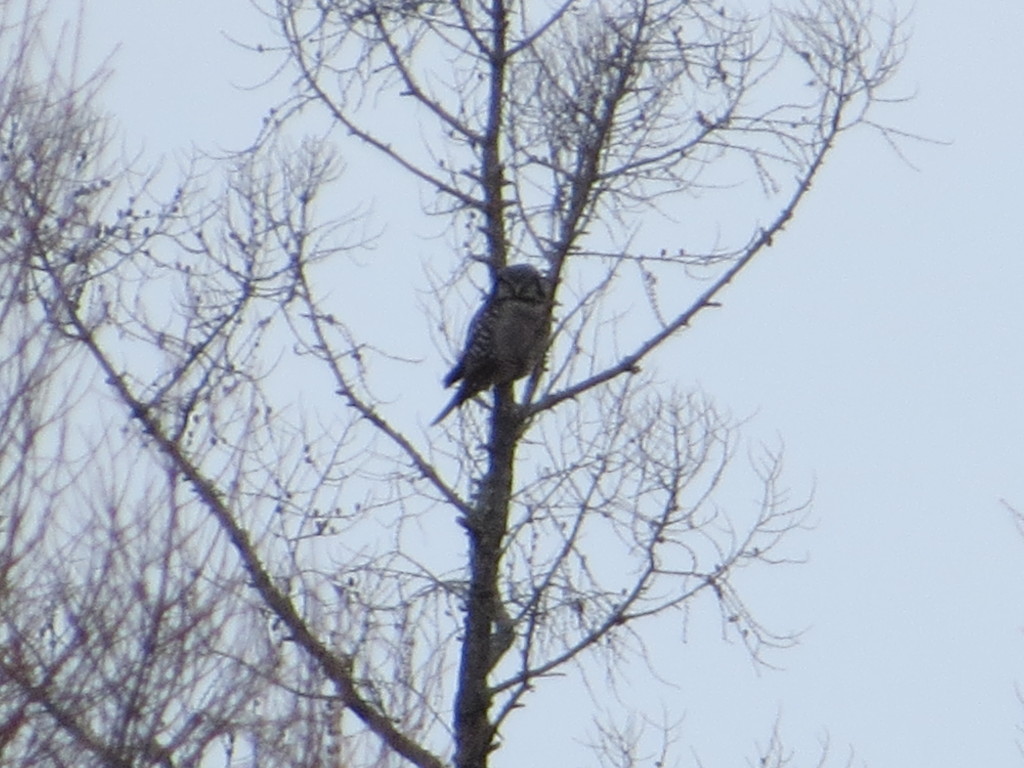
The bird flew to a more classic perch, doing his duty of acting Hawk Owlish for these Arizona guests. Tommy and I actually bushwhacked through the knee-deep snow to get some photos. Gordon stayed back on the road to watch the Hawk Owl through Tommy’s scope.
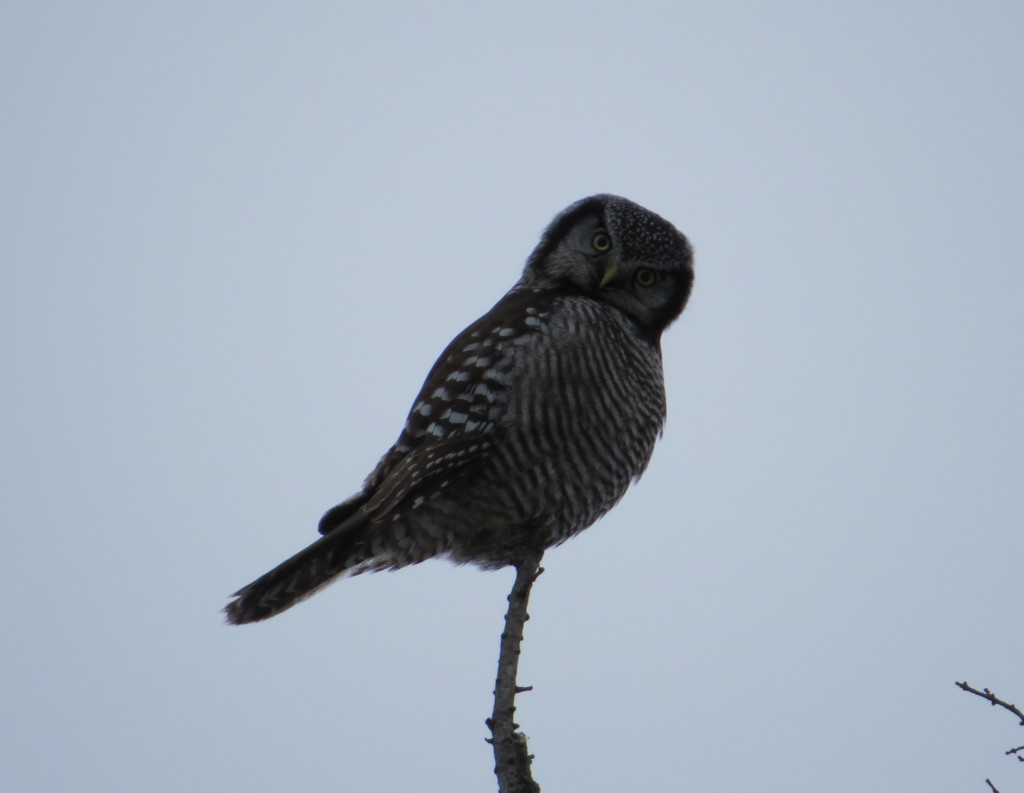 Turns out we needn’t have bushwhacked because this accommodating little fellow must have felt sorry for Gordon and flew practically right up to him. Even Gordon couldn’t resist wading into the snow for this new perch. Get ‘im Gordon!
Turns out we needn’t have bushwhacked because this accommodating little fellow must have felt sorry for Gordon and flew practically right up to him. Even Gordon couldn’t resist wading into the snow for this new perch. Get ‘im Gordon!
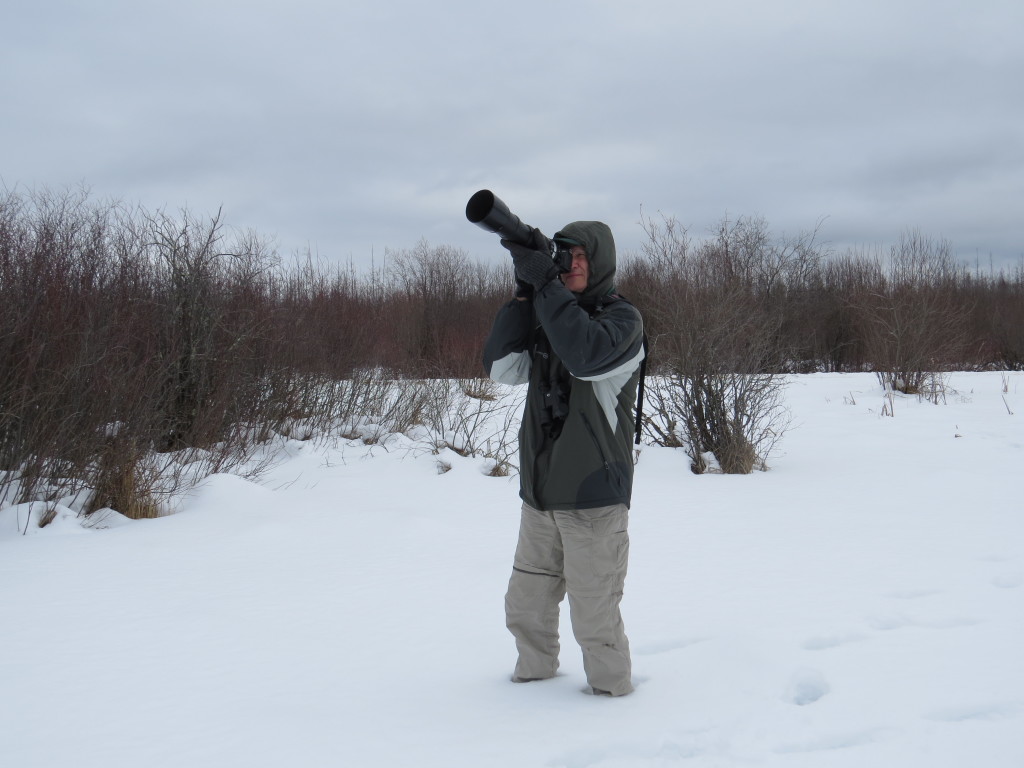 Get ‘im Tommy!
Get ‘im Tommy!
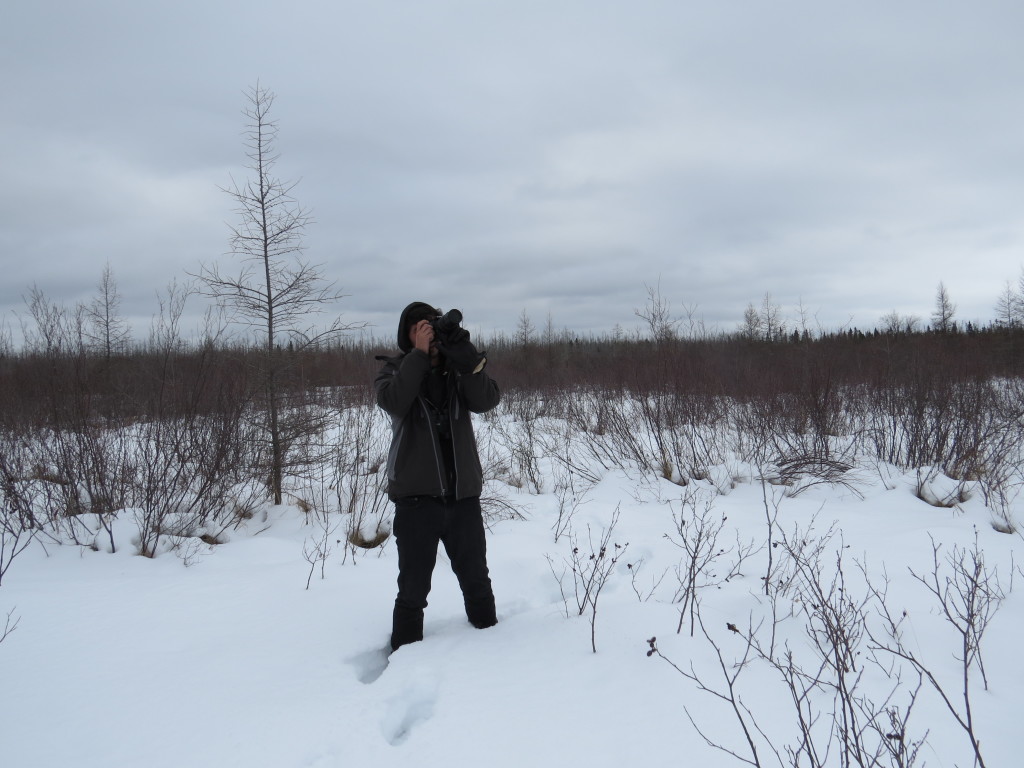 Even though the blue skies and the hoarfrost were gone, this was my favorite Hawk Owl experience of the day. We were totally alone in the middle of the remote Beltrami Island State Forest with this Owl. There was not even another bird around. Truly, it was an idyllic setting.
Even though the blue skies and the hoarfrost were gone, this was my favorite Hawk Owl experience of the day. We were totally alone in the middle of the remote Beltrami Island State Forest with this Owl. There was not even another bird around. Truly, it was an idyllic setting.
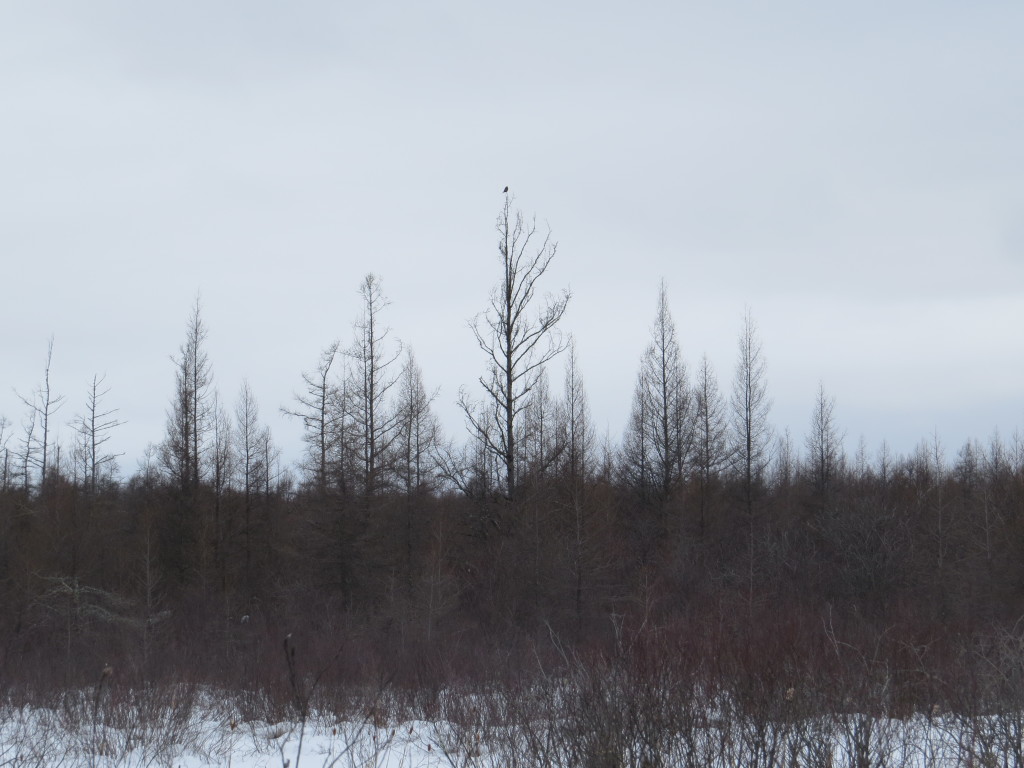
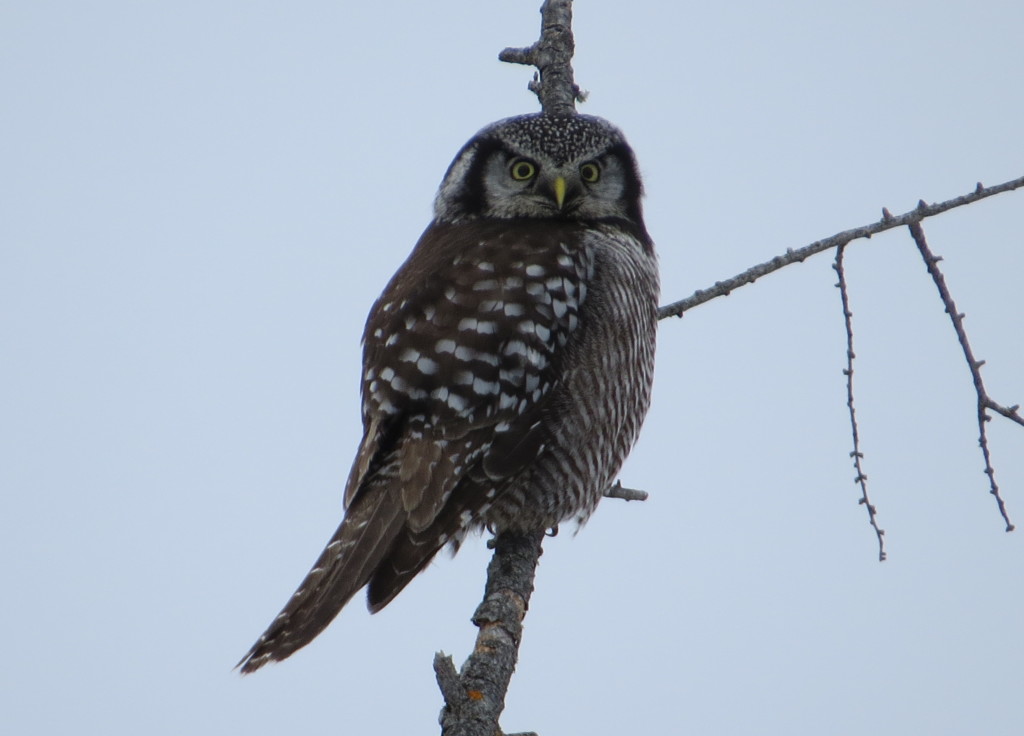
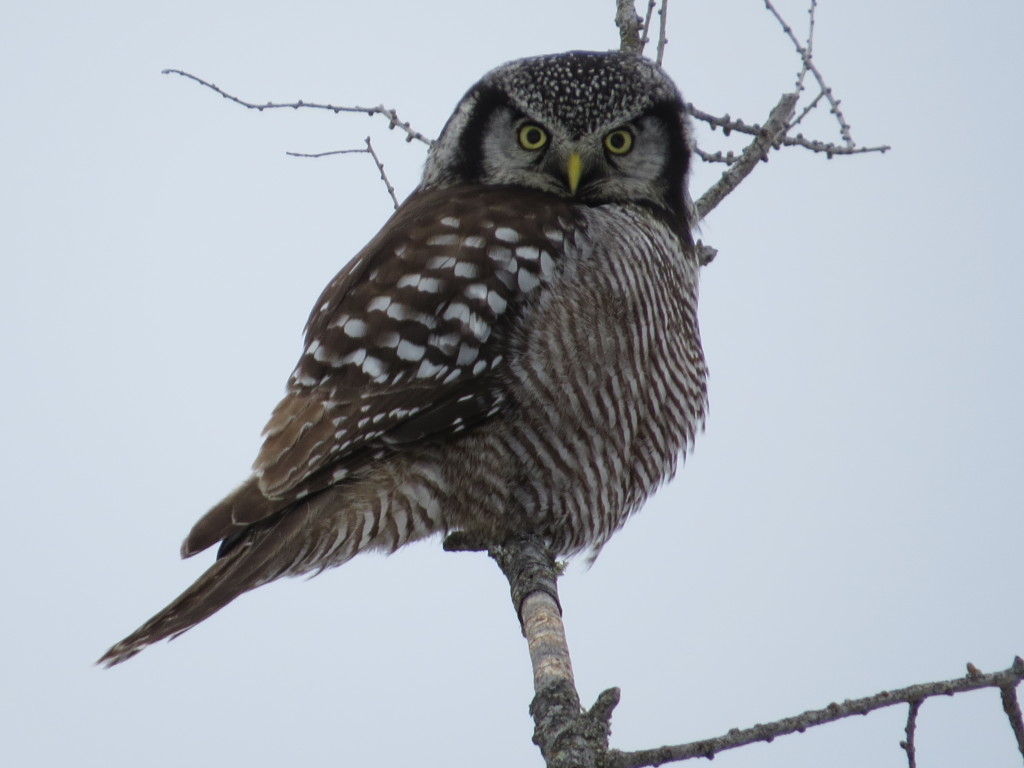
The rest of the drive through the Beltrami Island State Forest was uneventful birdwise. However, I did spy my lifer Bobcat!
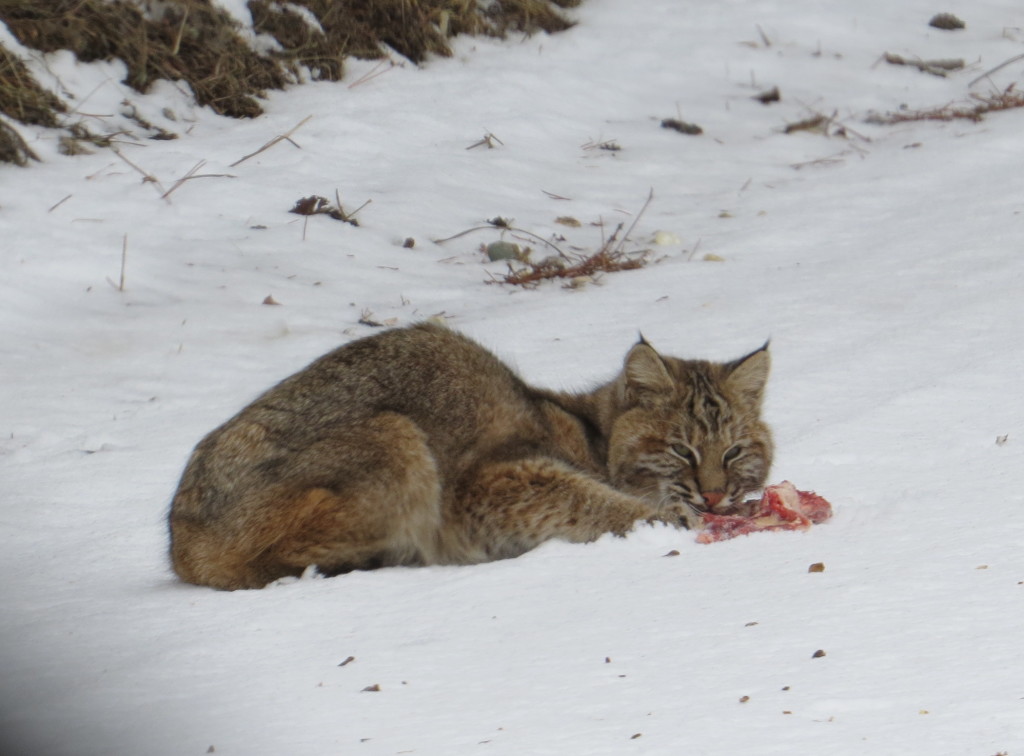 Upon closer inspection, though, it looked very sickly. It did not move even as we pulled up alongside it. While we watched, it made feeble attempts at gnawing on this slab of meat which came from where? Clearly this cat could not eat what was in front of it, let alone kill something. Sad.
Upon closer inspection, though, it looked very sickly. It did not move even as we pulled up alongside it. While we watched, it made feeble attempts at gnawing on this slab of meat which came from where? Clearly this cat could not eat what was in front of it, let alone kill something. Sad.
Continuing our journey, though, we drove the road north of the Faunce Fire Tower and looked for a reported Great Gray. The habitat was perfect, but the time of day was not, so we kept rolling. I decided to drive down the Pitt Grade Road where Black-backed Woodpeckers and Crossbills had been reported a month earlier. There was some snow on the road, but I thought the van could handle it. The more I drove, though, the more I realized that I was driving on a snowmobile trail! As the soft snow on either side of the skinny road was trying to pull me in, I realized I had to get us out of this situation. We could A) Keep driving, not knowing when or if we’d be able to get off this road, B) attempt a 99-point turn to get us turned around, or C) drive in reverse the entire 3.6 miles we had come. After much debate, we decided on the reverse option. I’ll never forget the look on Gordon’s face as I drove in reverse (trust me, I got a good look as I craned myself around to drive the stressful, painful, 3.6 mile, 15-minute trip all the way back). Thankfully, the reverse attempt was successful, and we were birding once again!
We made one pass for yet a third Hawk Owl south of Baudette on MN 72 a few miles. The habitat was again perfect, but we did not strike gold for the third time of the day. I’m sure if we would have made more passes, we eventually would have spotted it. Instead, it was time to finish the long drive back to Angora.
Somewhere west of International Falls as Tommy and Gordon were fading in and out of sleep, I caught sight of a large, gray Owl fly out from the Aspen stand on the north side of MN 11! I hollered, “Great Gray!” but as we got glass on it, we saw it was something even better! It was the guys’ lifer Barred Owl, their 4th Owl lifer of the trip!!!! Woo-hoo!!
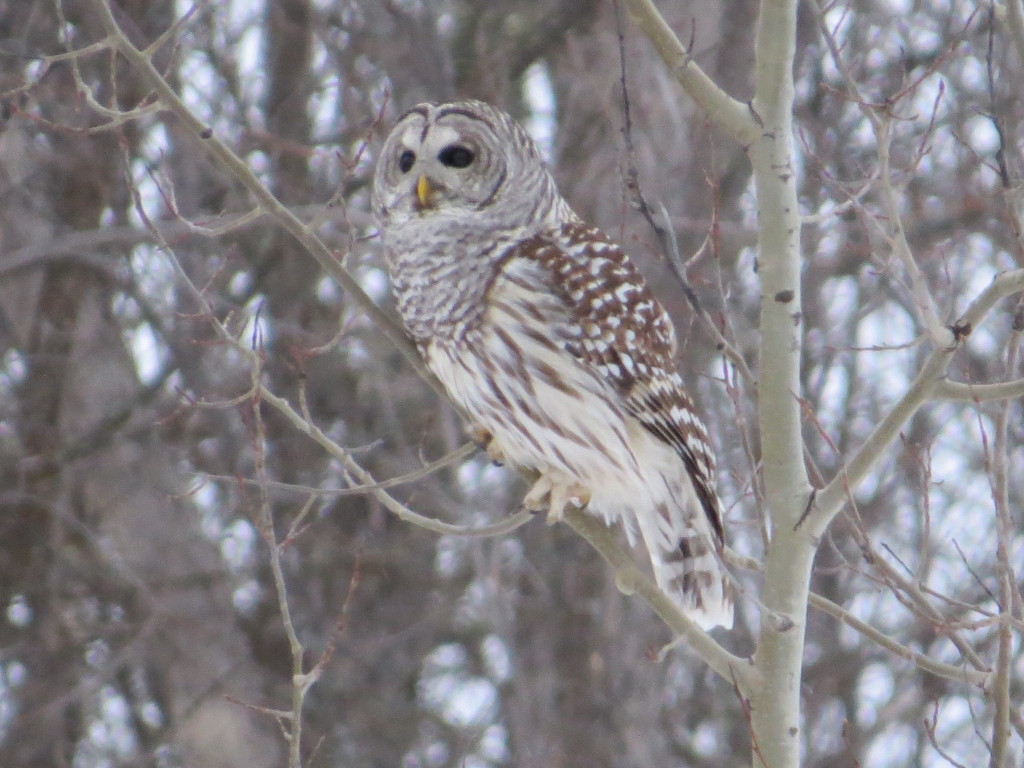 Talk about a way to wake up the guys up and get the birding juices flowing again! This was personally exciting for me as it was only my 2nd personally found Barred and 4th one ever. That’s right, I’ve seen more of the “special” northern Owls than I have of this common, resident bird. It was a real treat indeed.
Talk about a way to wake up the guys up and get the birding juices flowing again! This was personally exciting for me as it was only my 2nd personally found Barred and 4th one ever. That’s right, I’ve seen more of the “special” northern Owls than I have of this common, resident bird. It was a real treat indeed.
This encounter must have brought a jolt of life back into Tommy because somewhere just south of Ray on U.S. Highway 53, Tommy spotted us our 5th Owl species of the trip, a Great Horned Owl! What a day! What a trip!
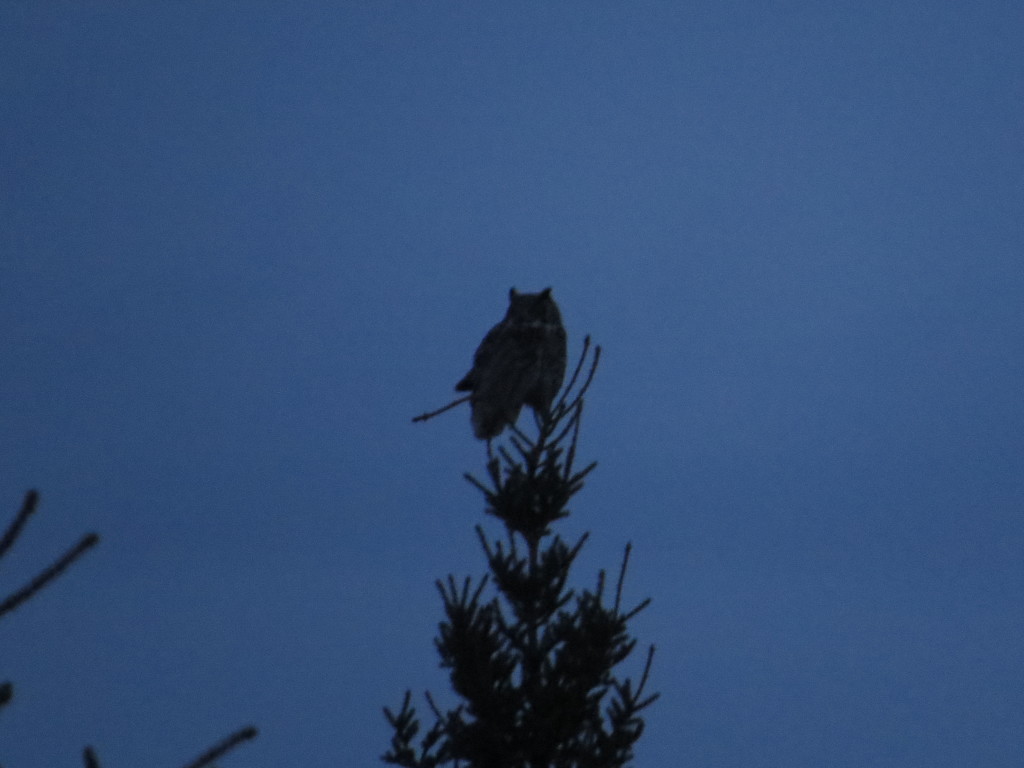 It was an incredible trip to the Northwest and one I won’t forget anytime soon. The day was capped off with a hot meal at the Wooden Table in Angora and the relaxation of knowing that we could “sleep in” the next day even though we had another exciting birding itinerary for the day of Tommy and Gordon’s departure.
It was an incredible trip to the Northwest and one I won’t forget anytime soon. The day was capped off with a hot meal at the Wooden Table in Angora and the relaxation of knowing that we could “sleep in” the next day even though we had another exciting birding itinerary for the day of Tommy and Gordon’s departure.
Here is a recap of the day’s lifers:
Northern Hawk Owl – Tommy, Gordon
Pileated Woodpecker – Tommy, Gordon
Snow Bunting – Tommy, Gordon
Barred Owl – Tommy, Gordon
A huge shout-out and thanks to Sandy Aubol for her Hawk Owl find and for her tips on relocating it! Thanks Sandy!

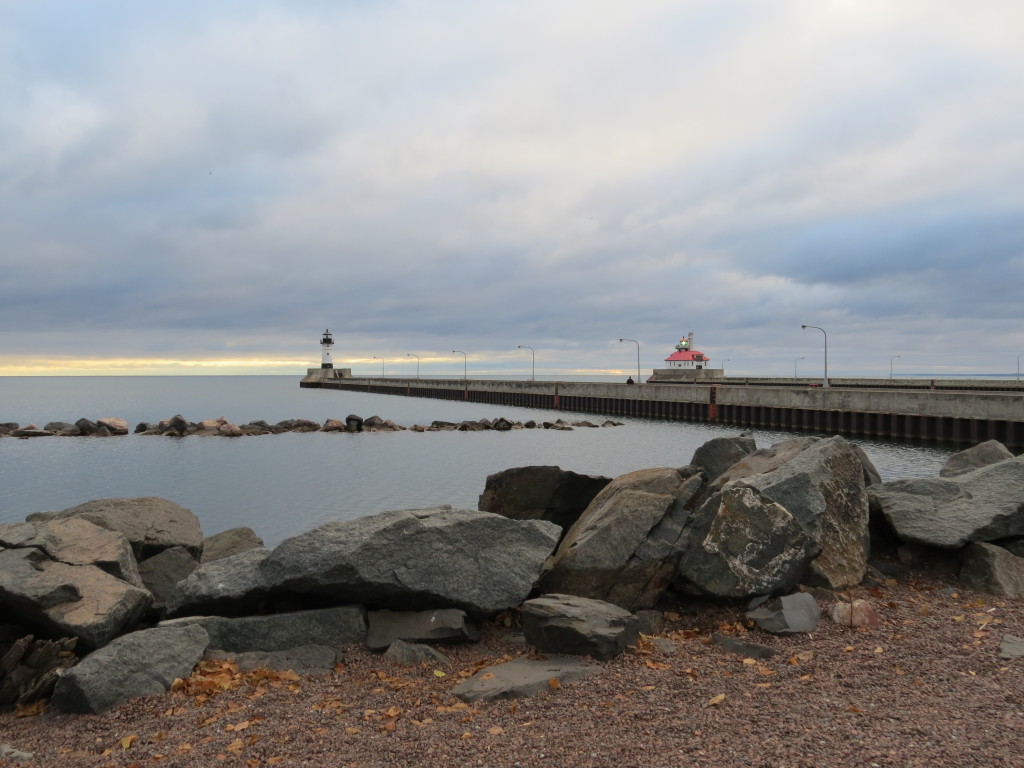 There has been a gaping hole in our Minnesota bird collection. We have traveled extensively throughout the state and have pretty much seen all the specialty birds tucked into hidden nooks and little-known crannies. Despite that fact, we have neglected one of the state’s most important birding areas – Lake Superior. Here the possibilities for new birds abound with many sea duck species, northern gull species, oddball loon species and even three jaeger species. I have never known how to approach birding the big water from the vast 150 miles of shoreline between Duluth and the Canadian border. I had long ago figured that someday I might just have to hire a guide for a day to learn how to bird this sea-environment. A couple weeks ago, though, I saw that Clinton Nienhaus was leading a FREE field trip through the Duluth Audubon Society along the North Shore specifically to look for sea ducks. Free is always good, unless it’s a puppy, so I went for it. Visions of Scoters and Harlequin Ducks danced in my head while I awaited this trip.
There has been a gaping hole in our Minnesota bird collection. We have traveled extensively throughout the state and have pretty much seen all the specialty birds tucked into hidden nooks and little-known crannies. Despite that fact, we have neglected one of the state’s most important birding areas – Lake Superior. Here the possibilities for new birds abound with many sea duck species, northern gull species, oddball loon species and even three jaeger species. I have never known how to approach birding the big water from the vast 150 miles of shoreline between Duluth and the Canadian border. I had long ago figured that someday I might just have to hire a guide for a day to learn how to bird this sea-environment. A couple weeks ago, though, I saw that Clinton Nienhaus was leading a FREE field trip through the Duluth Audubon Society along the North Shore specifically to look for sea ducks. Free is always good, unless it’s a puppy, so I went for it. Visions of Scoters and Harlequin Ducks danced in my head while I awaited this trip.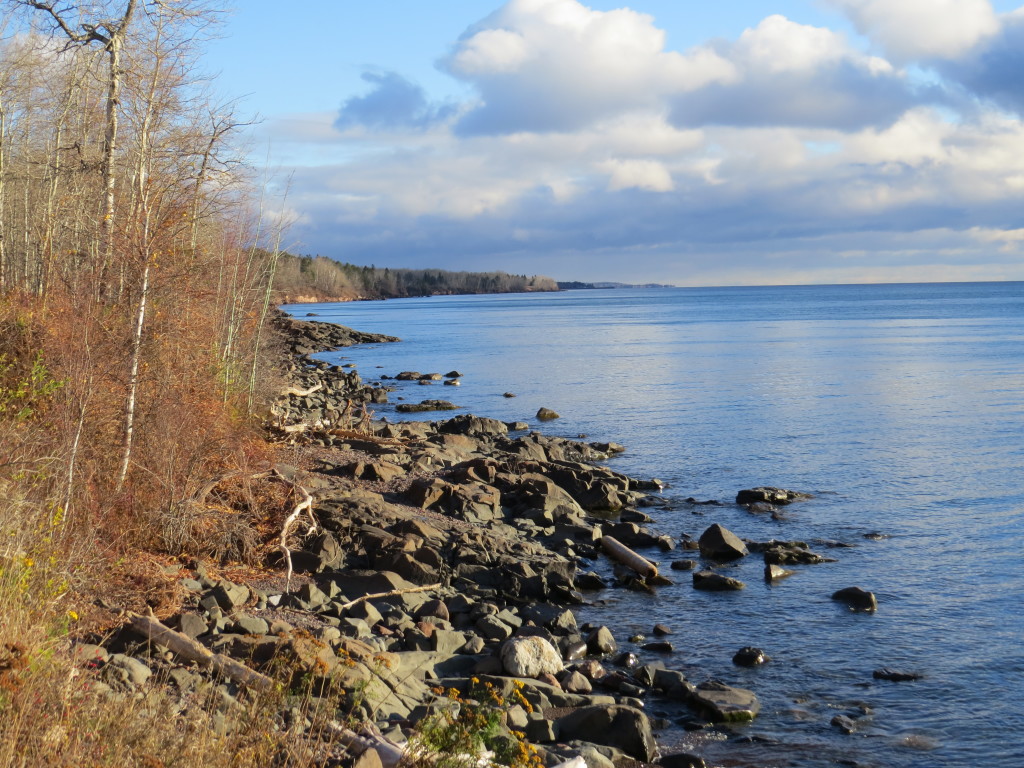
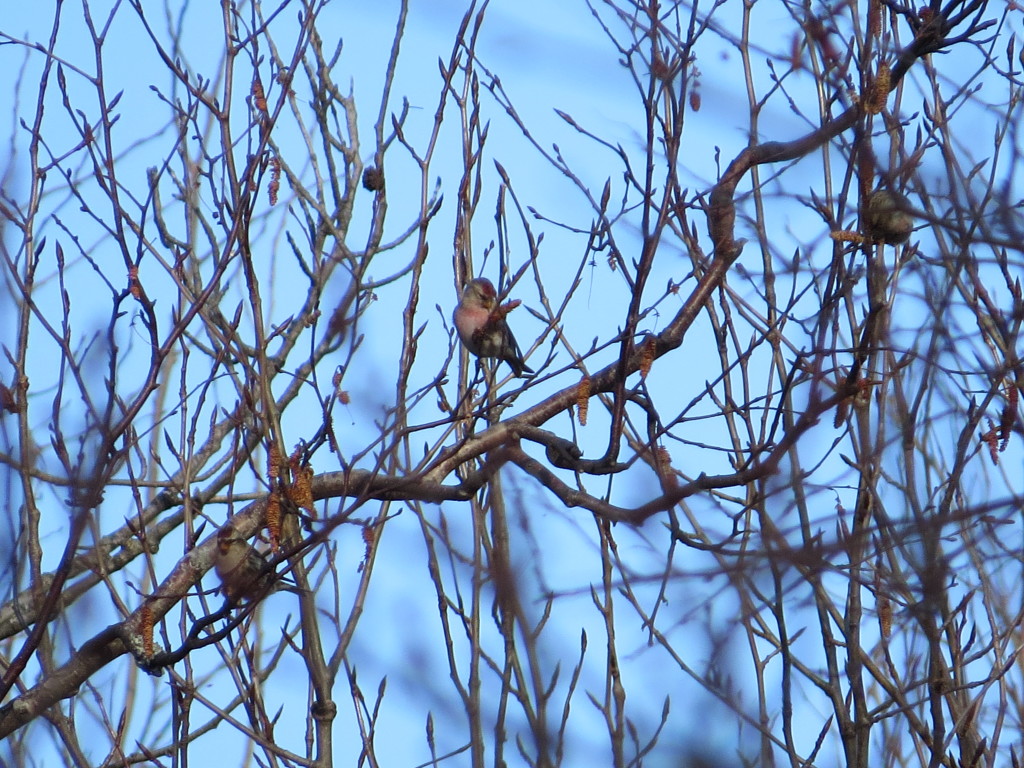
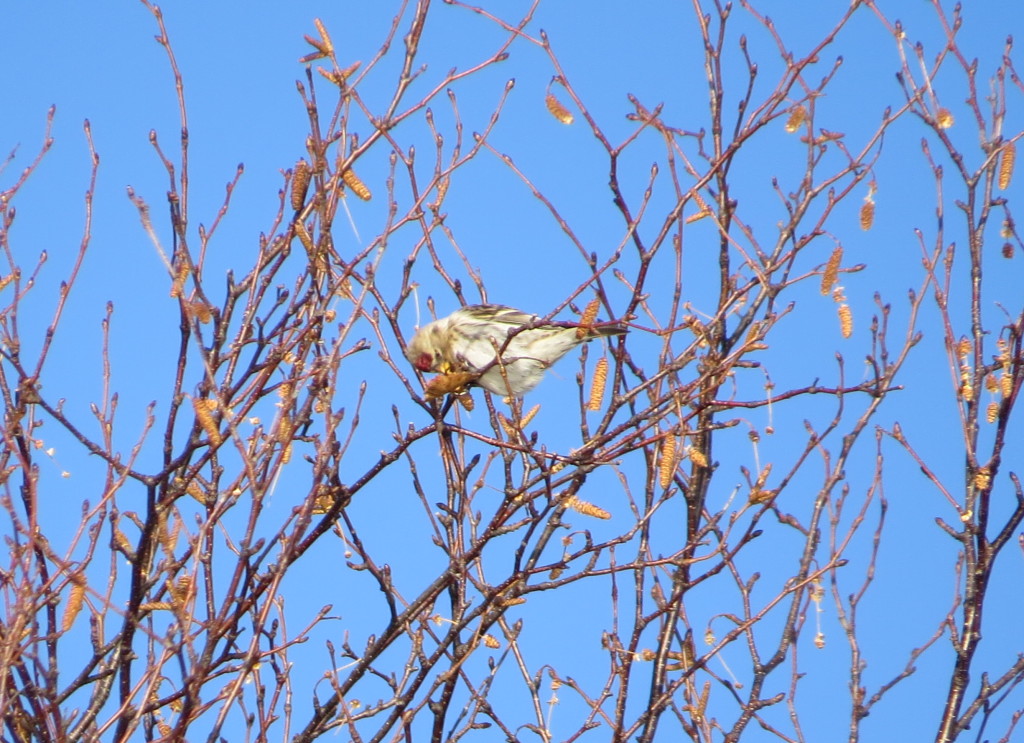
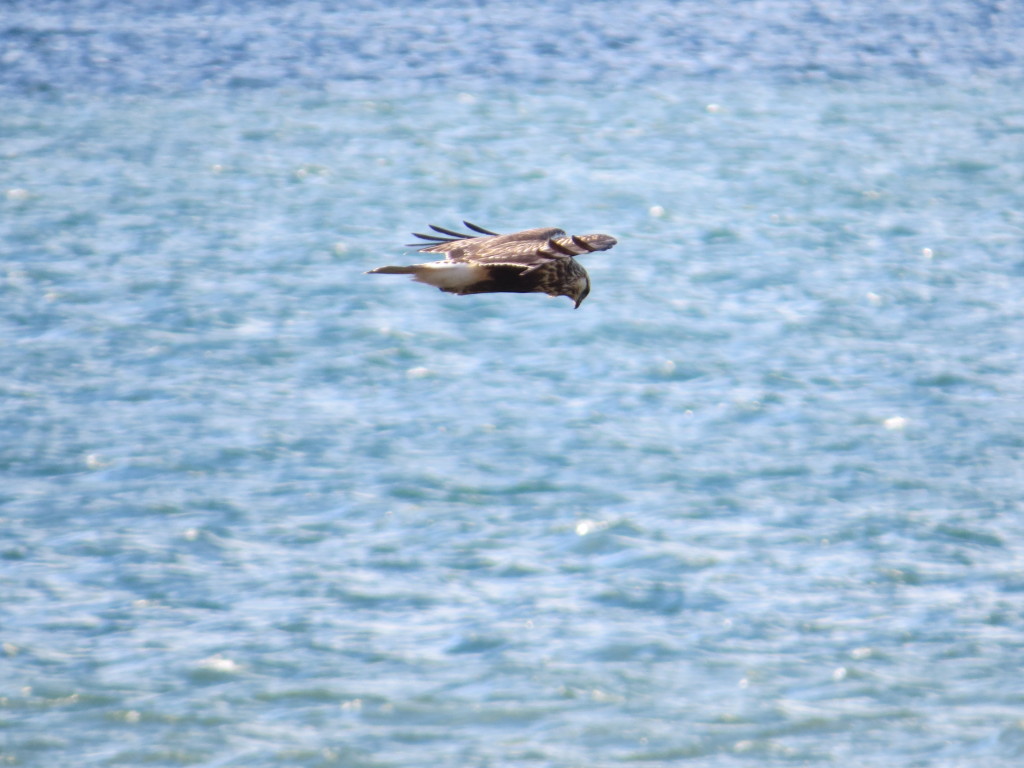
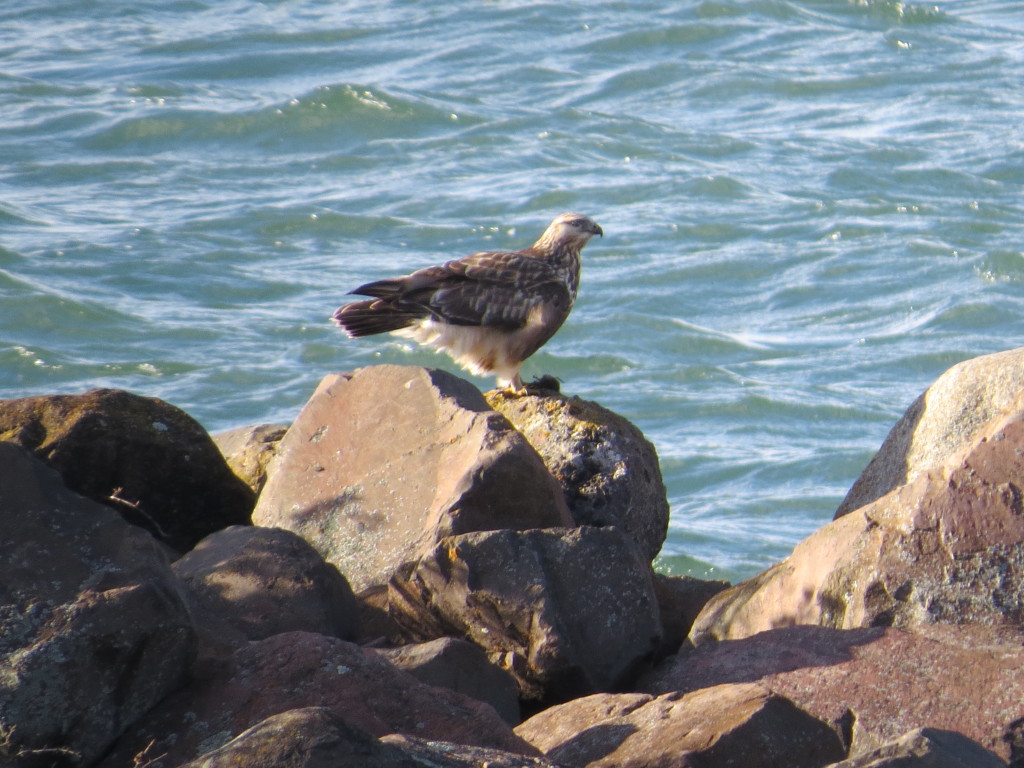
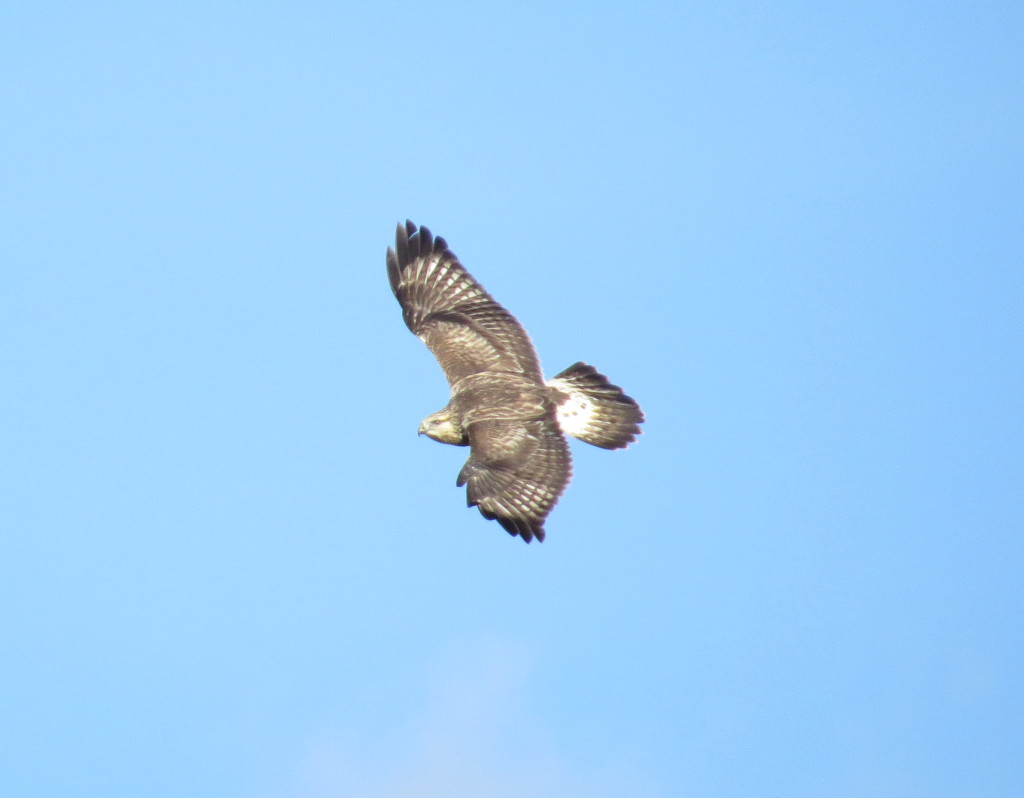
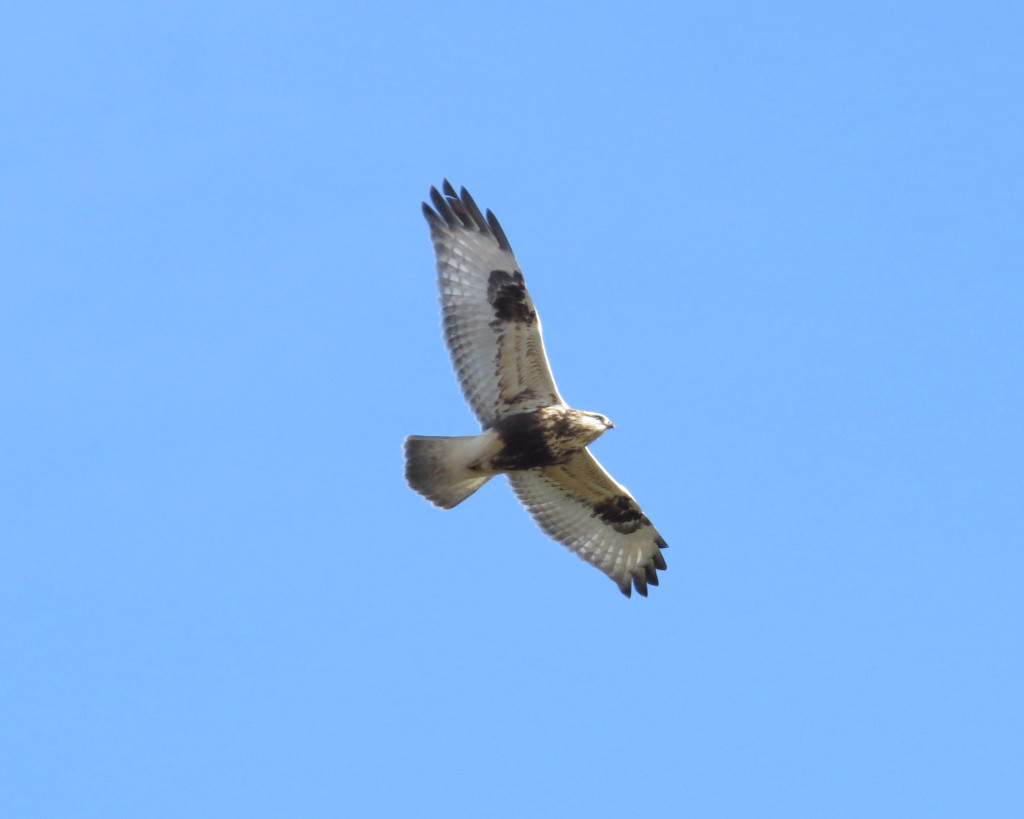
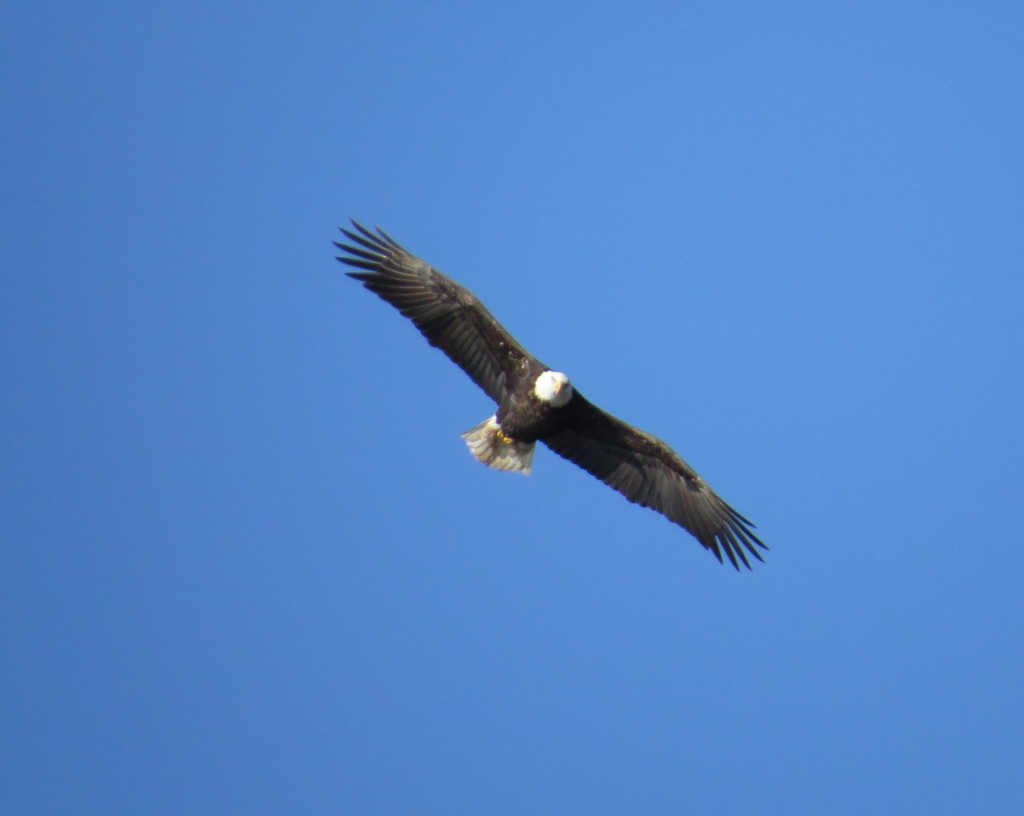
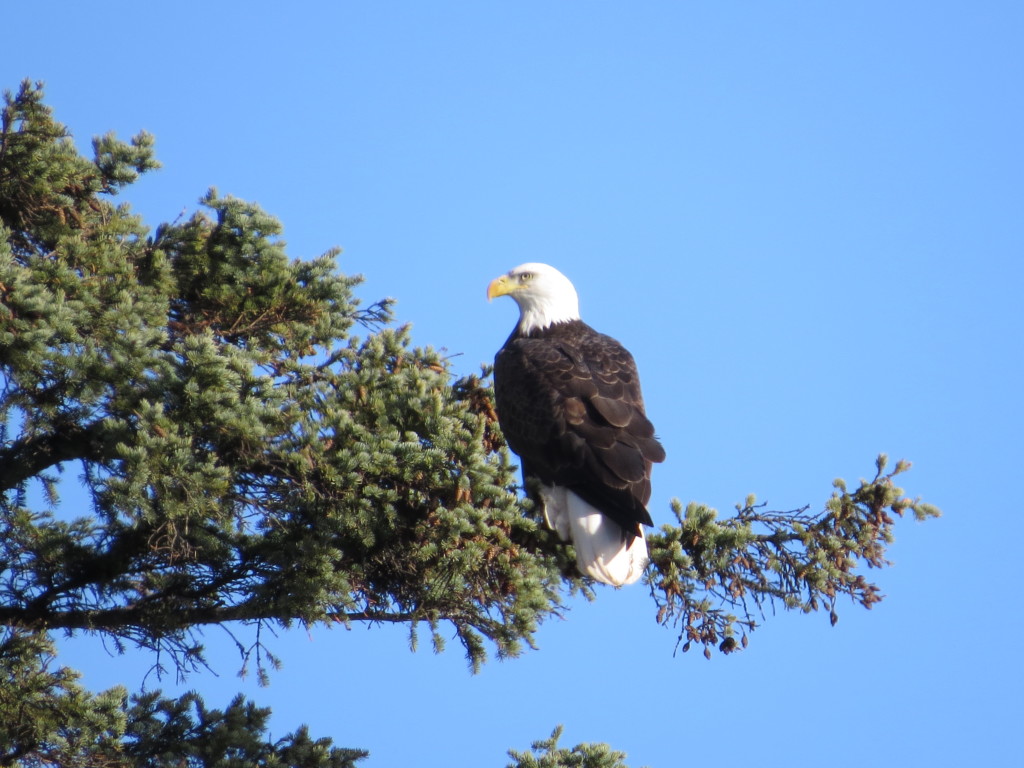
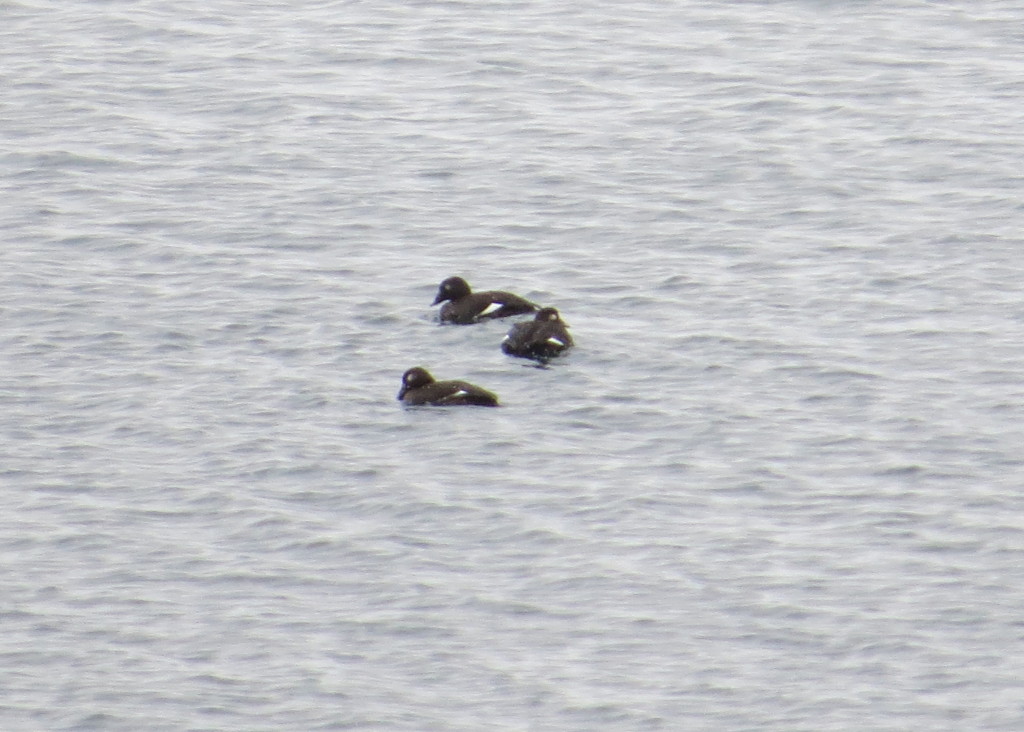 I was hoping for closer looks, but distance was a factor…
I was hoping for closer looks, but distance was a factor…